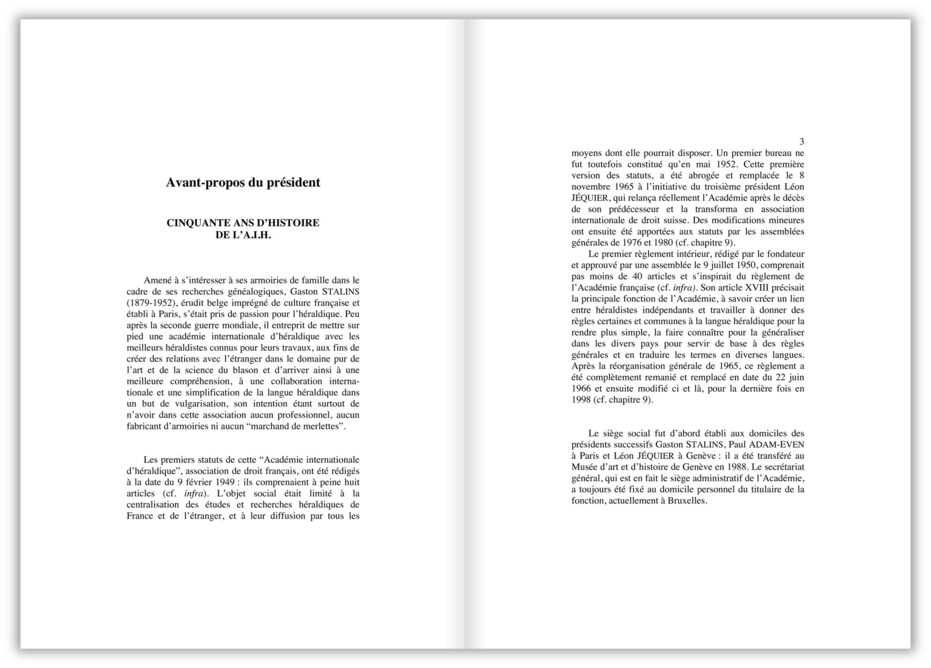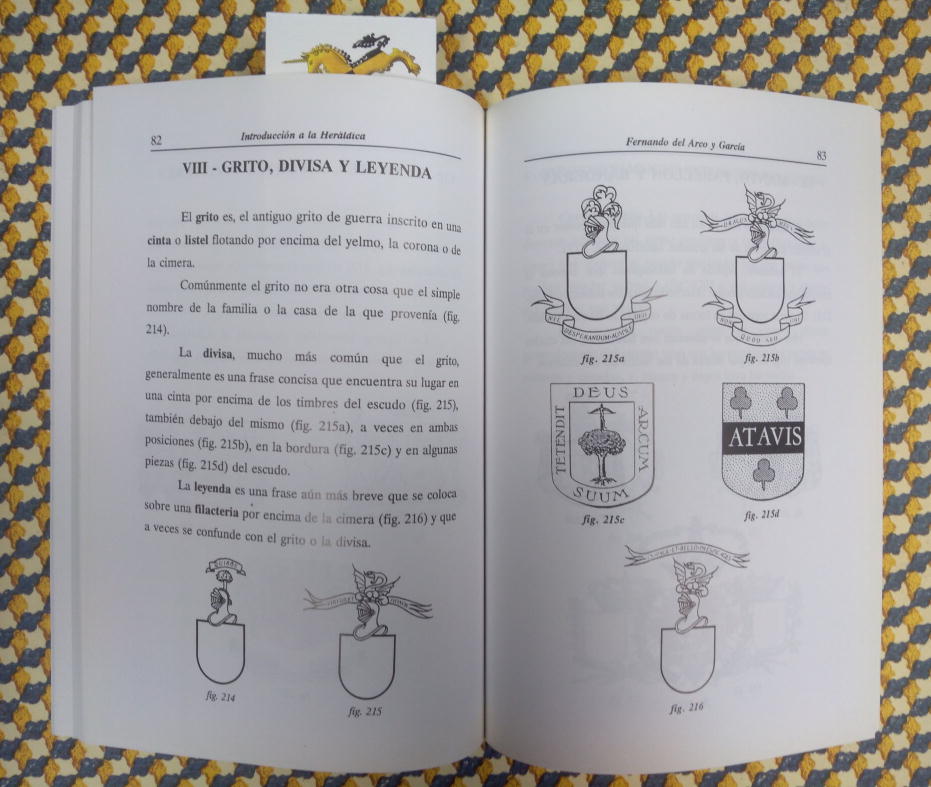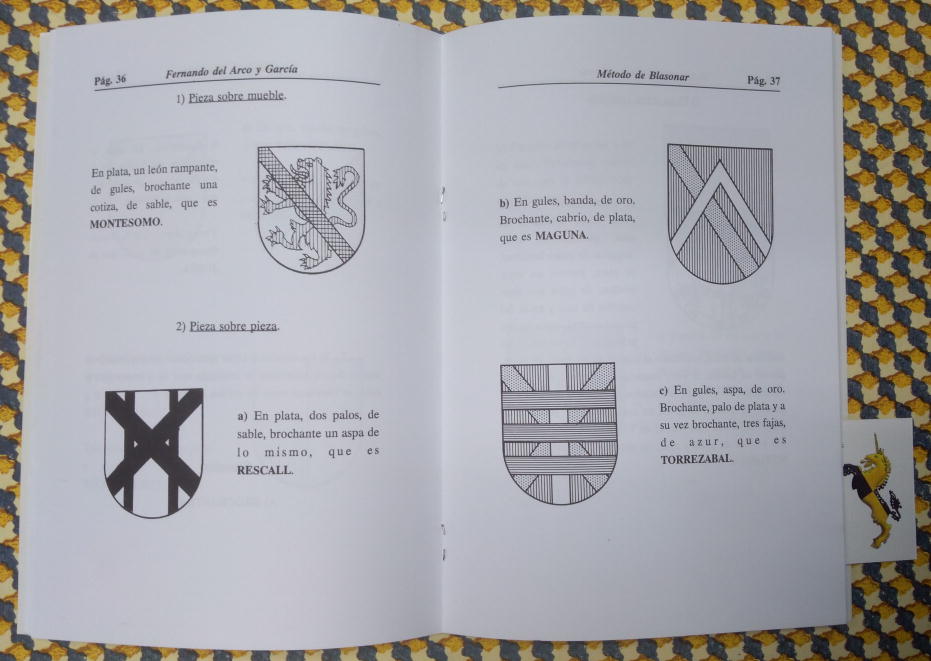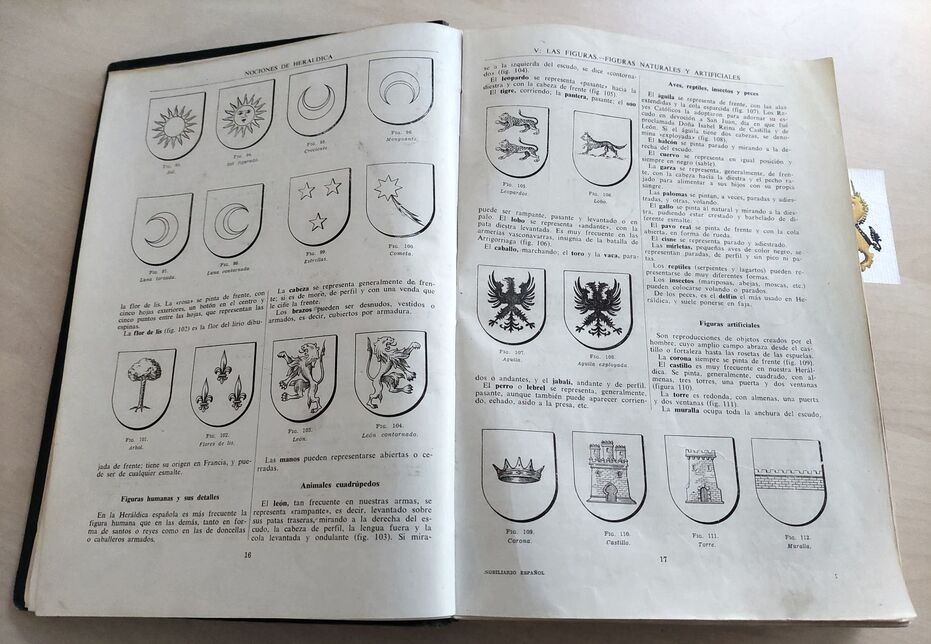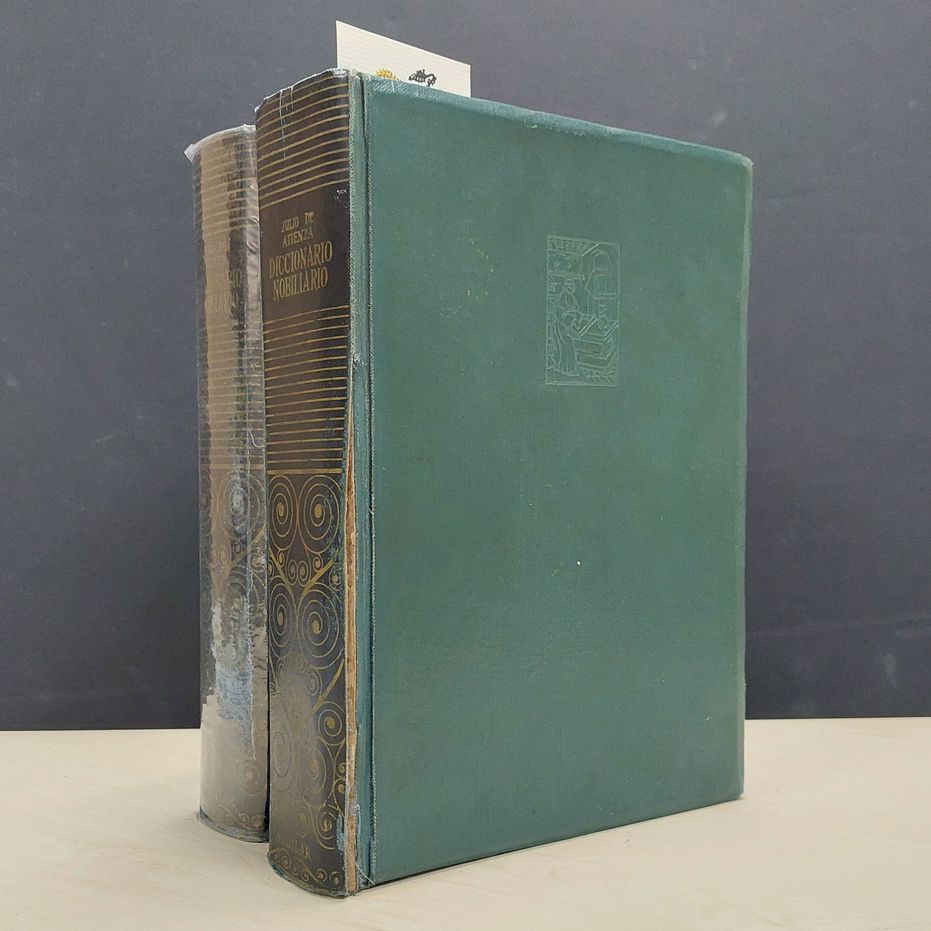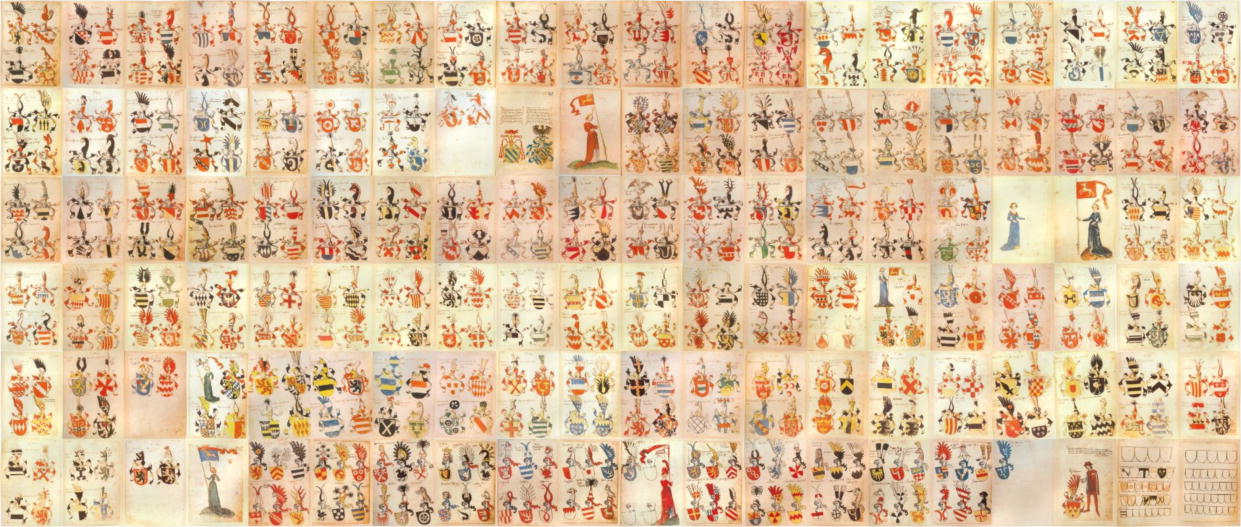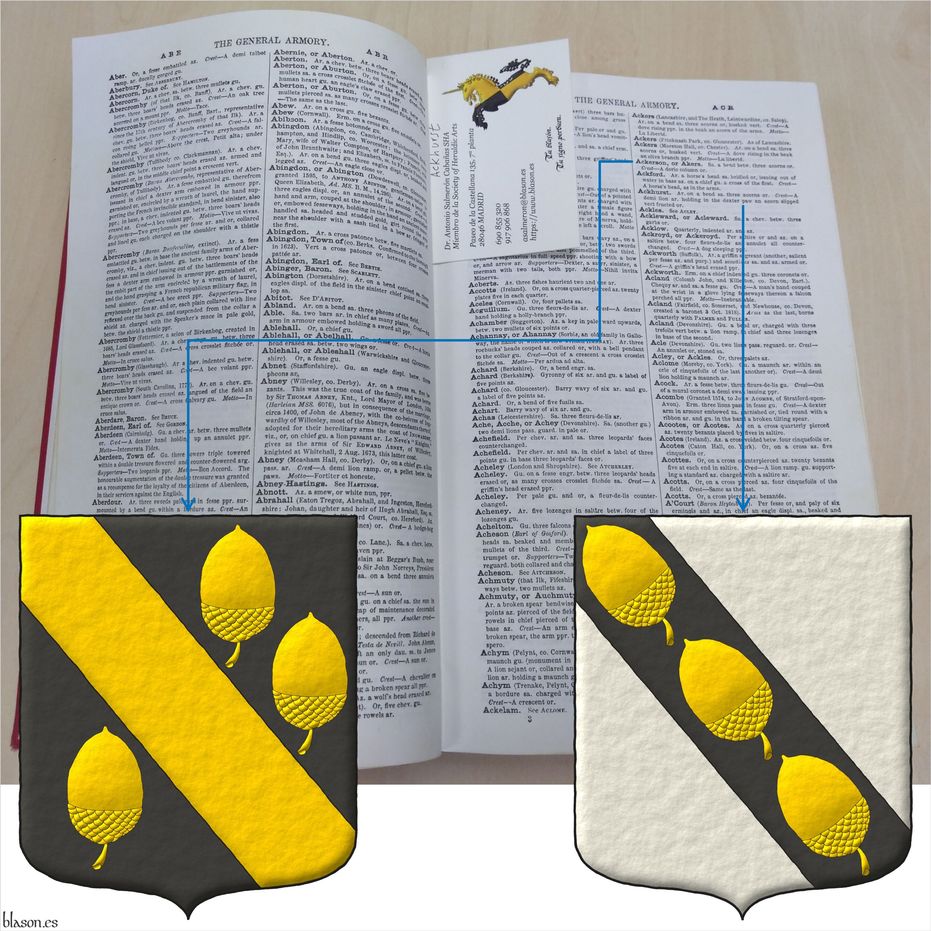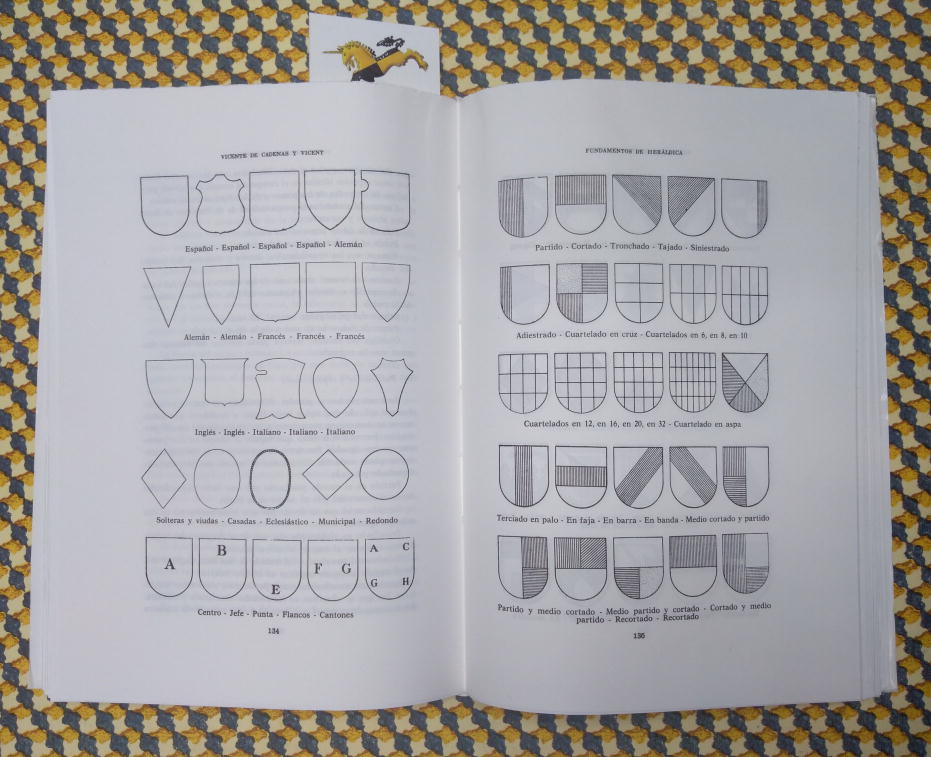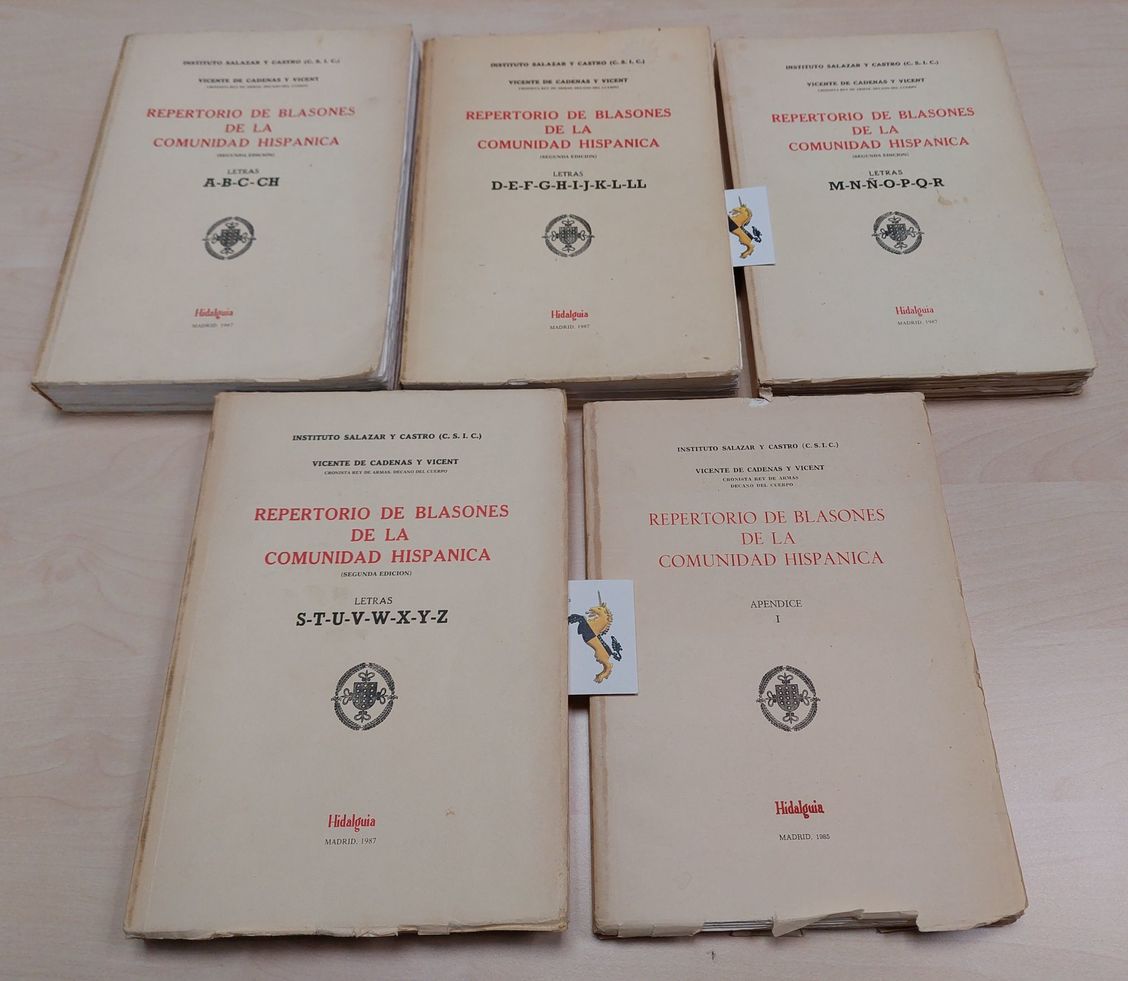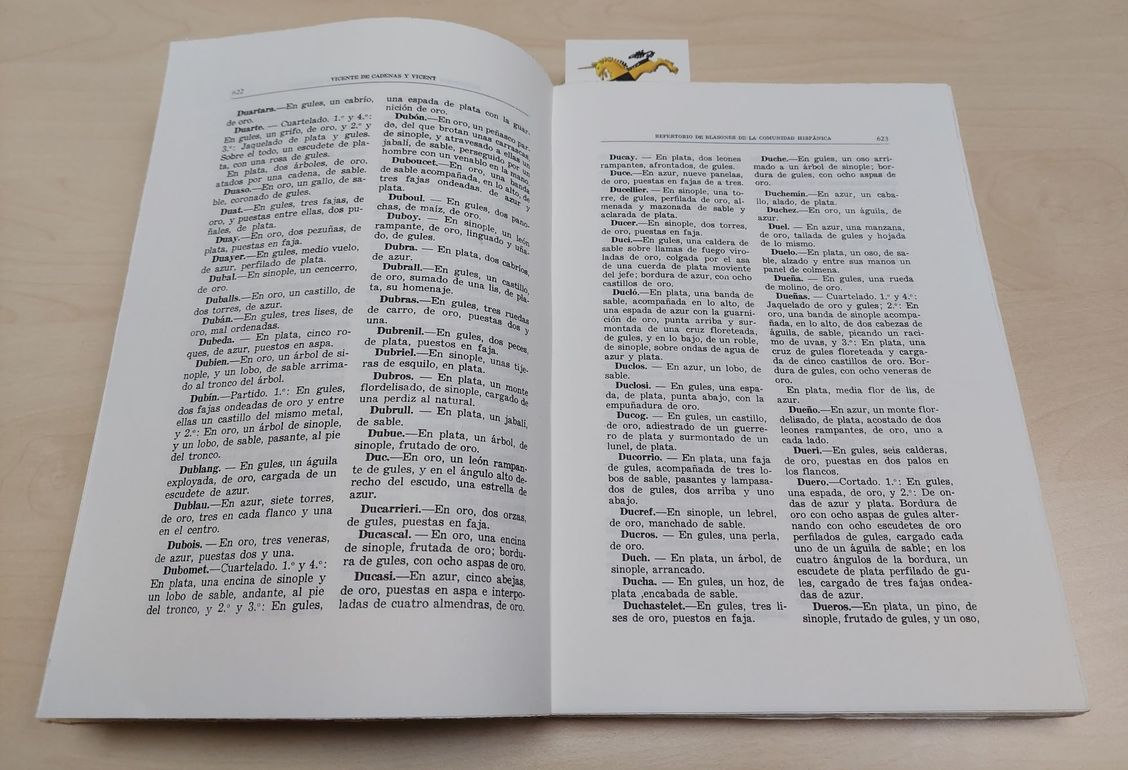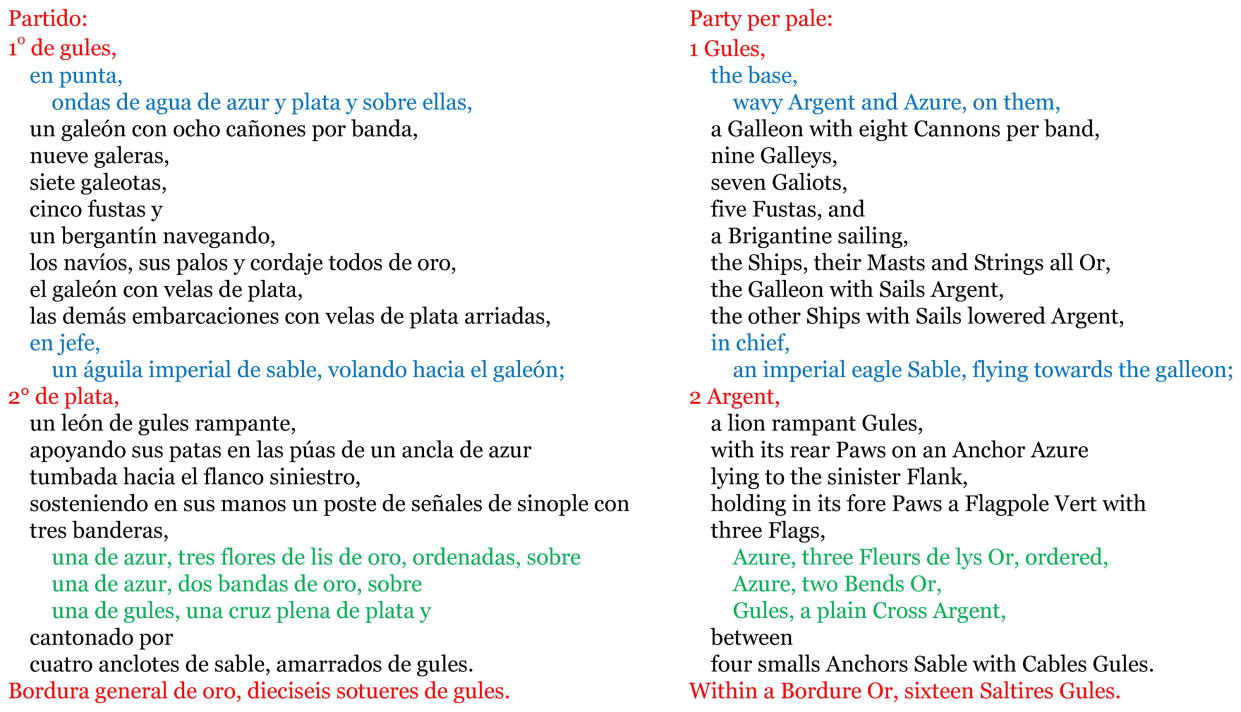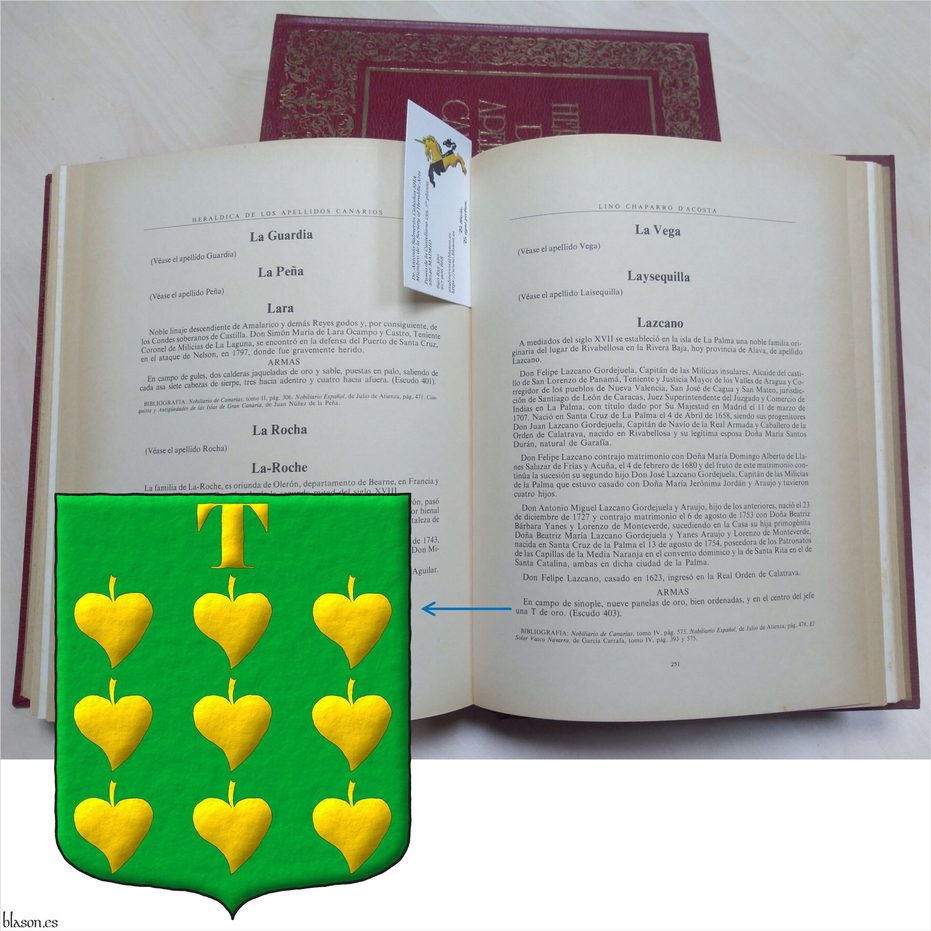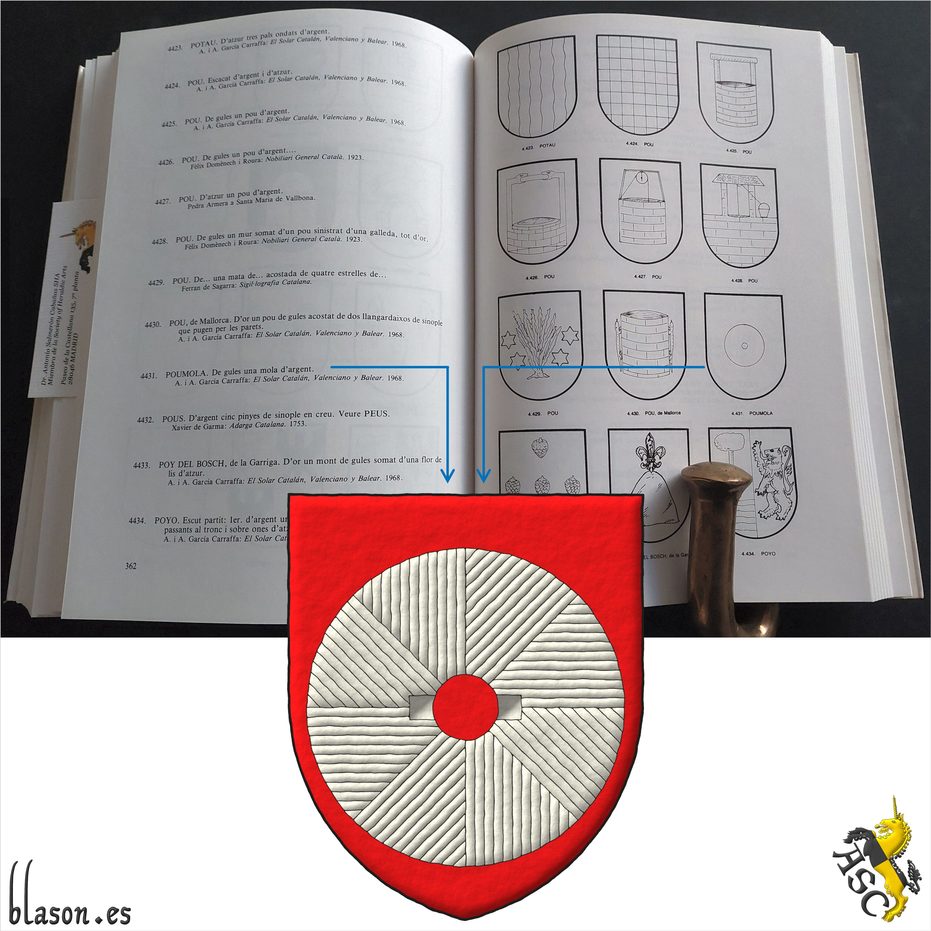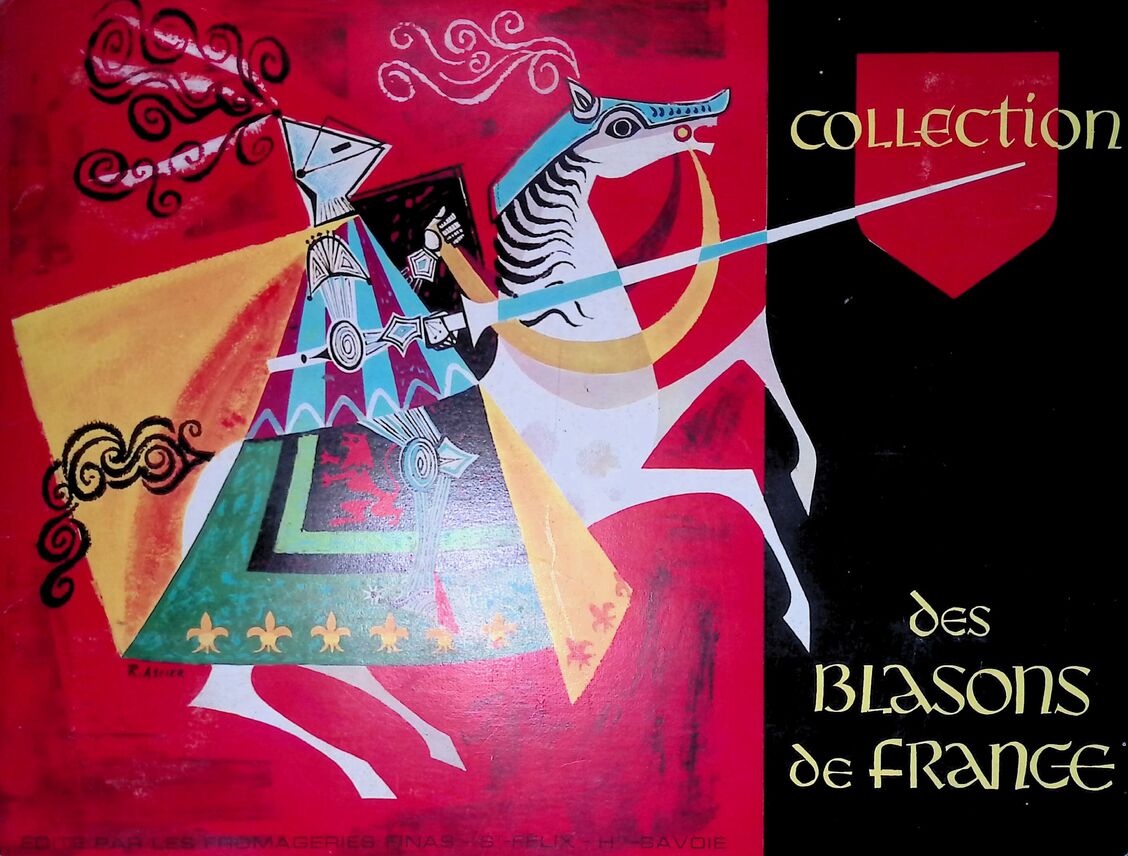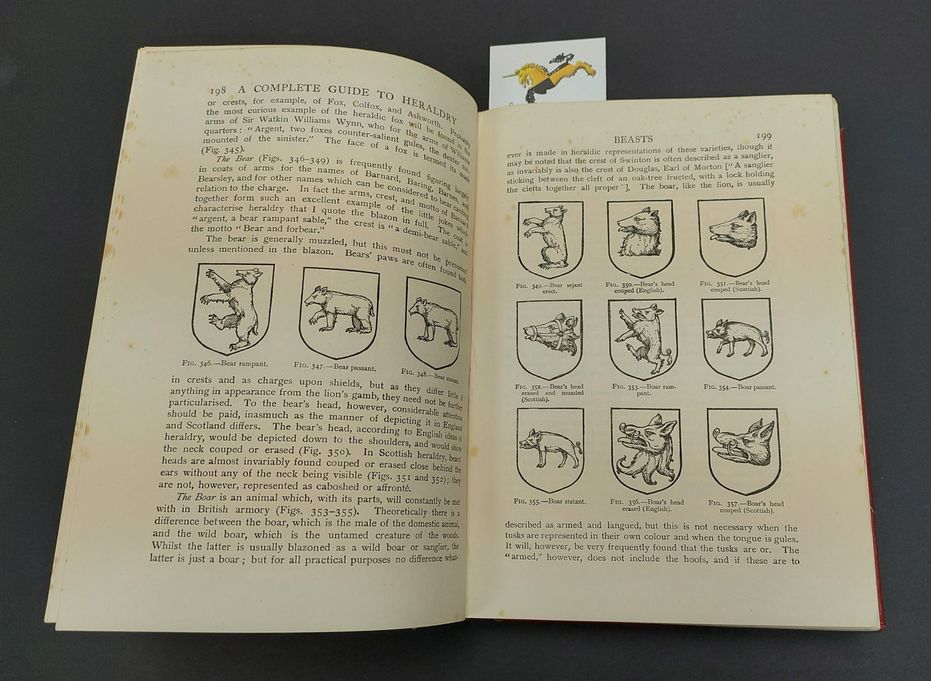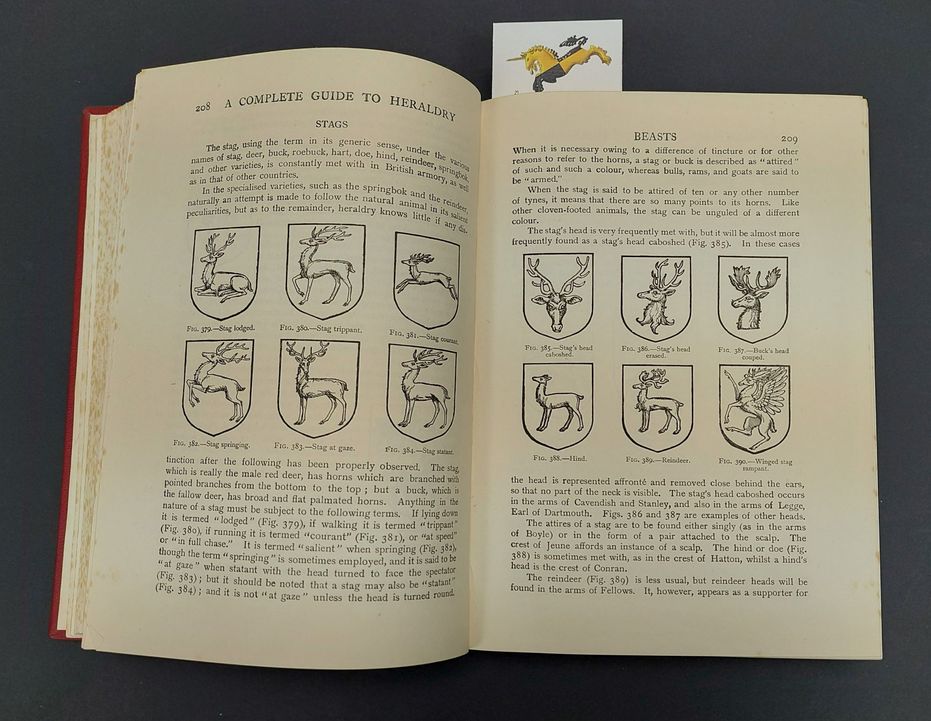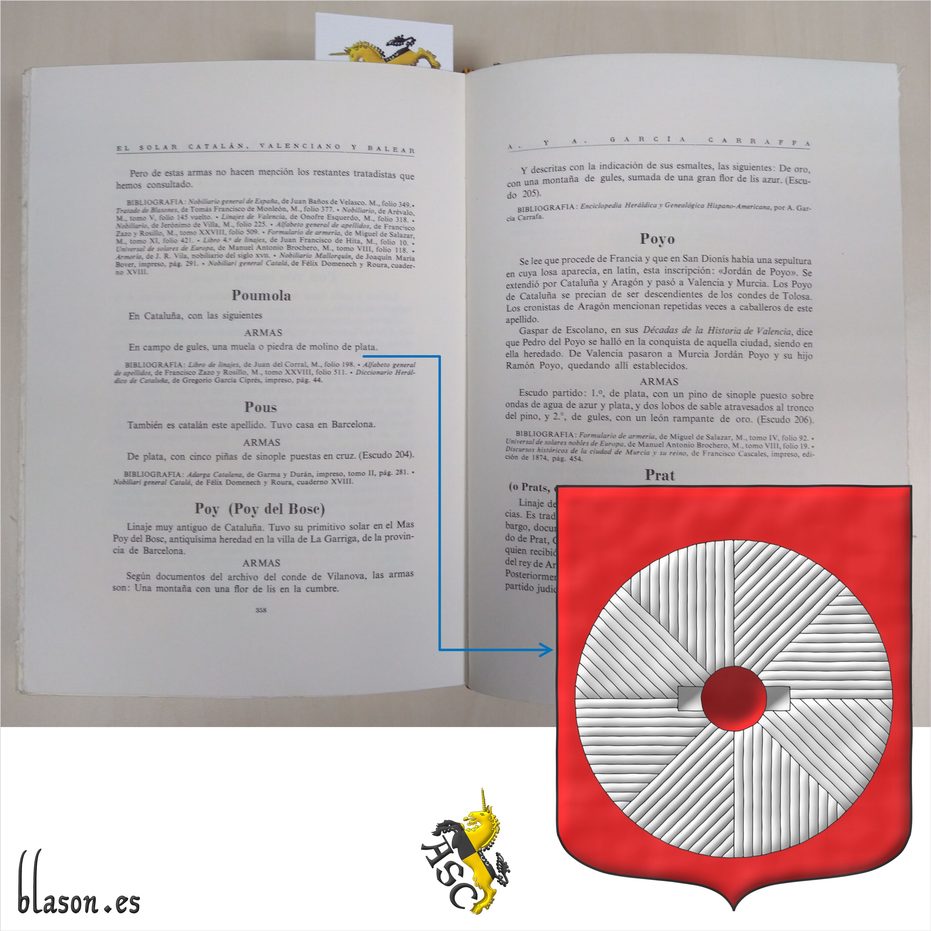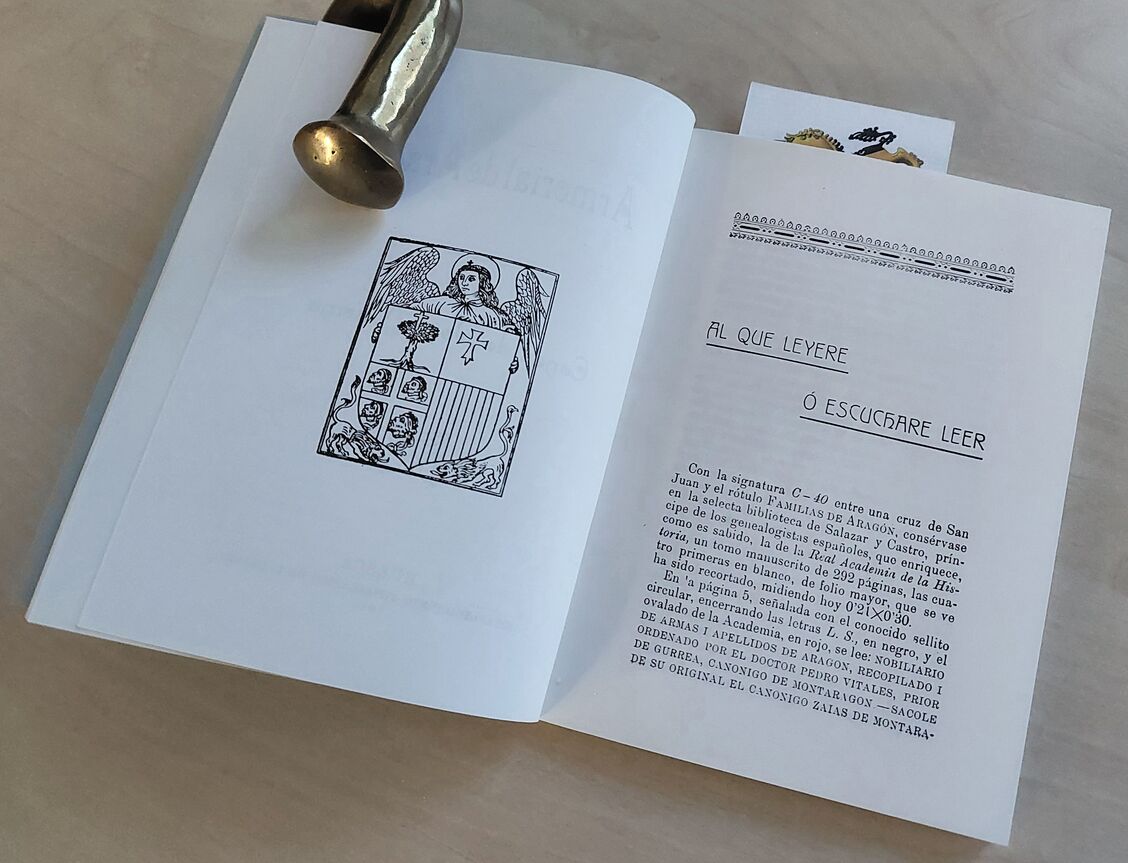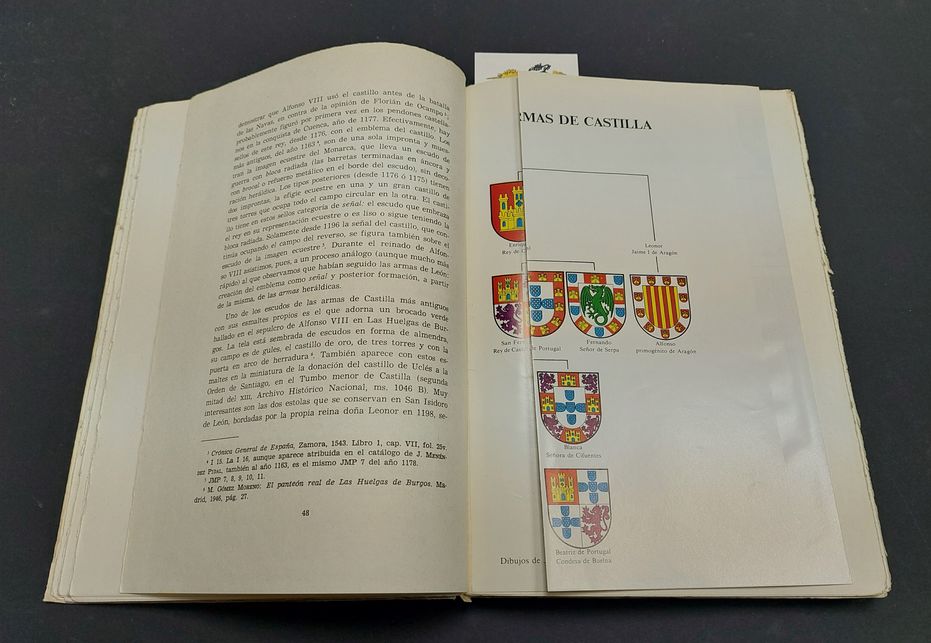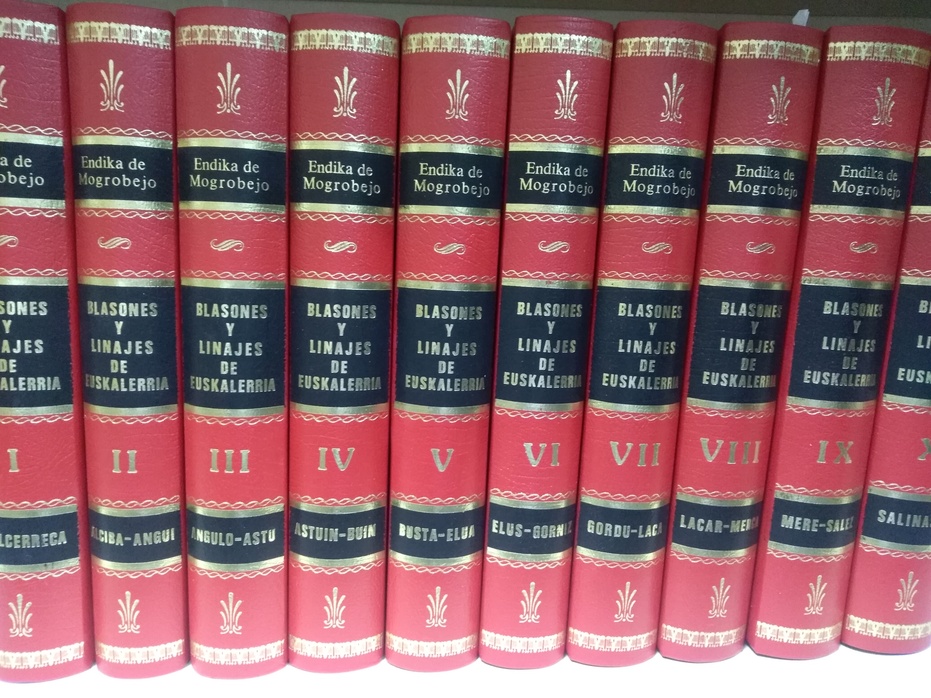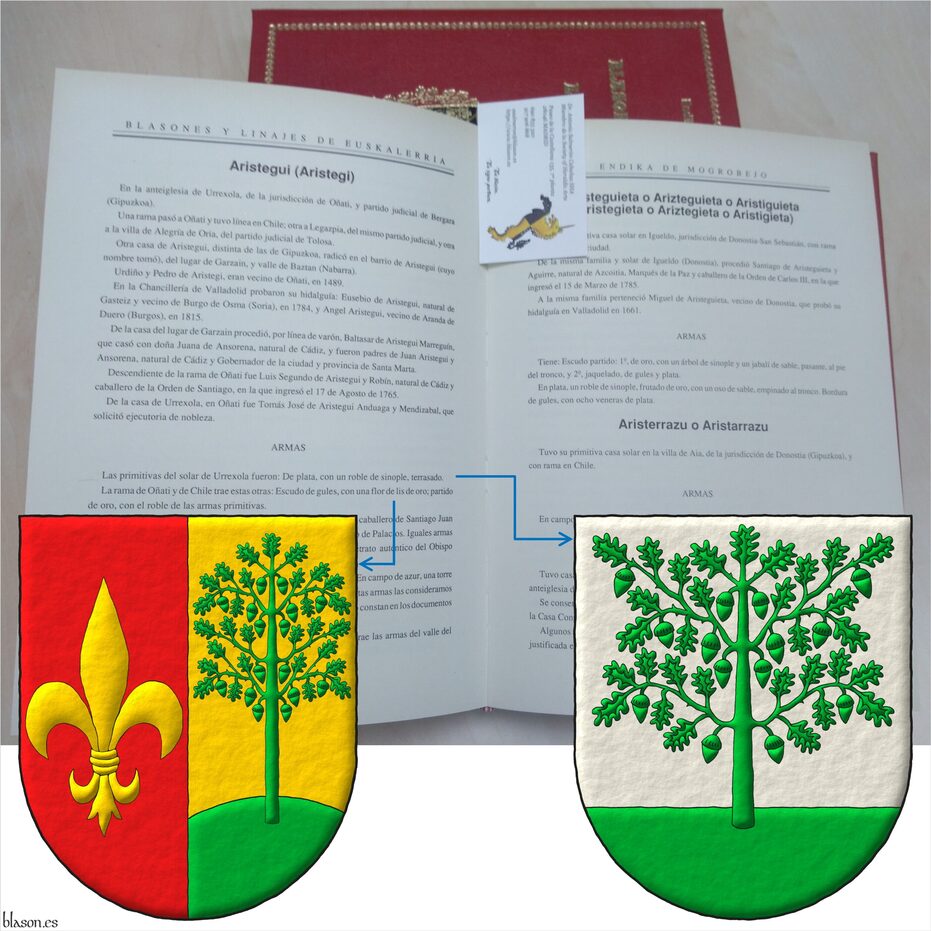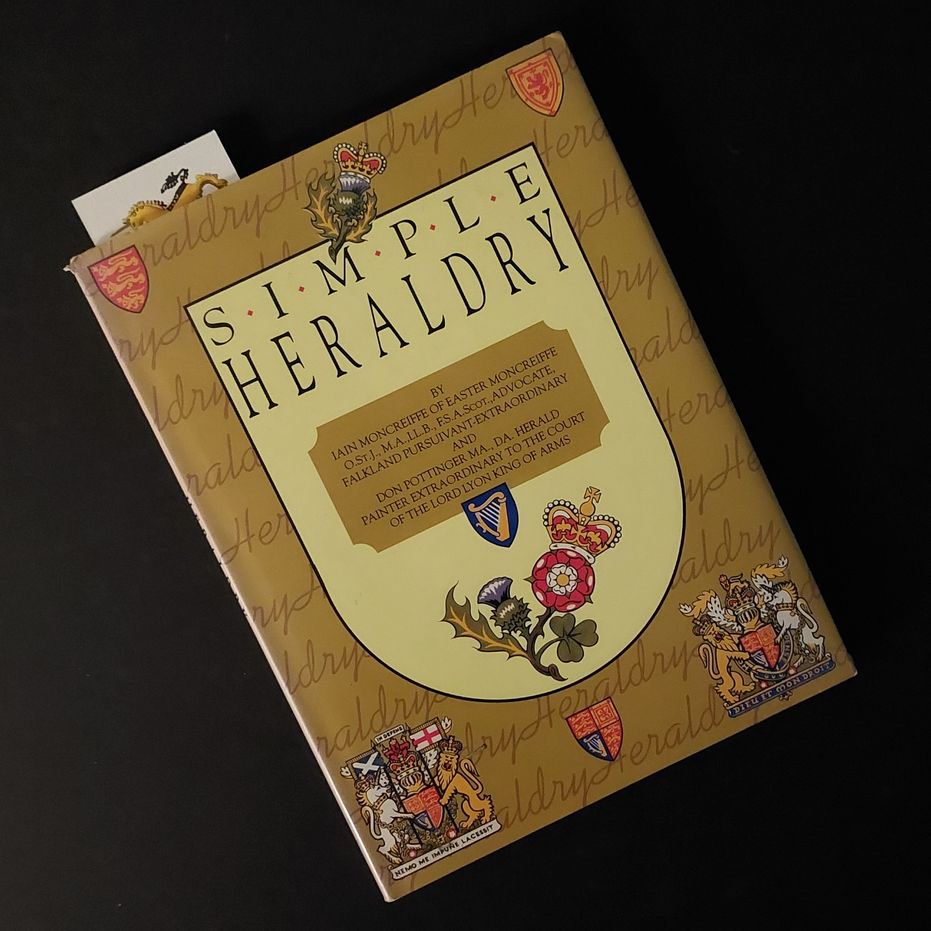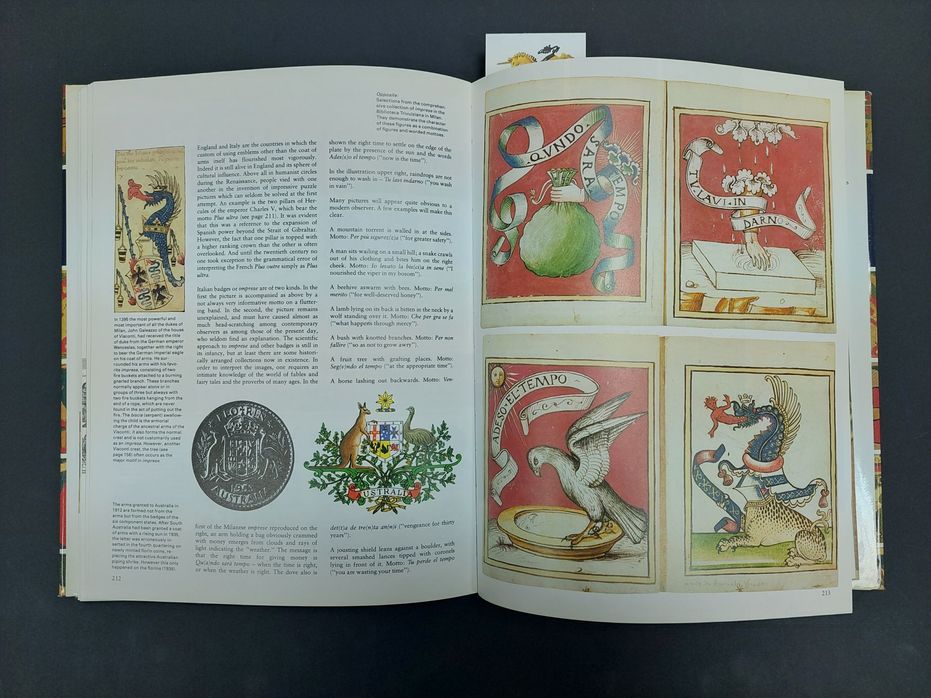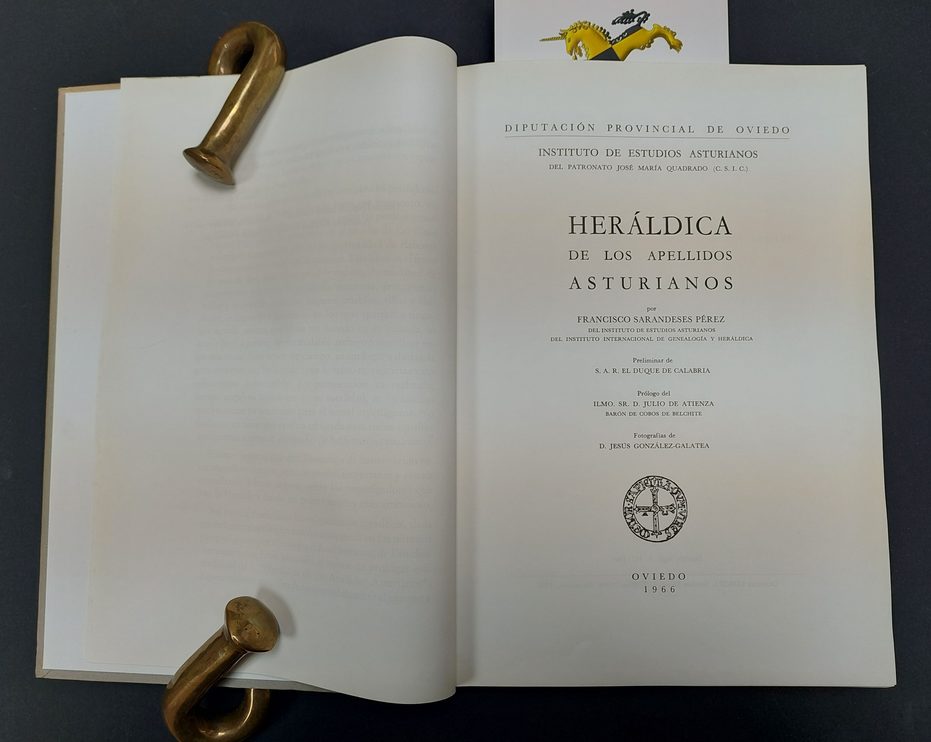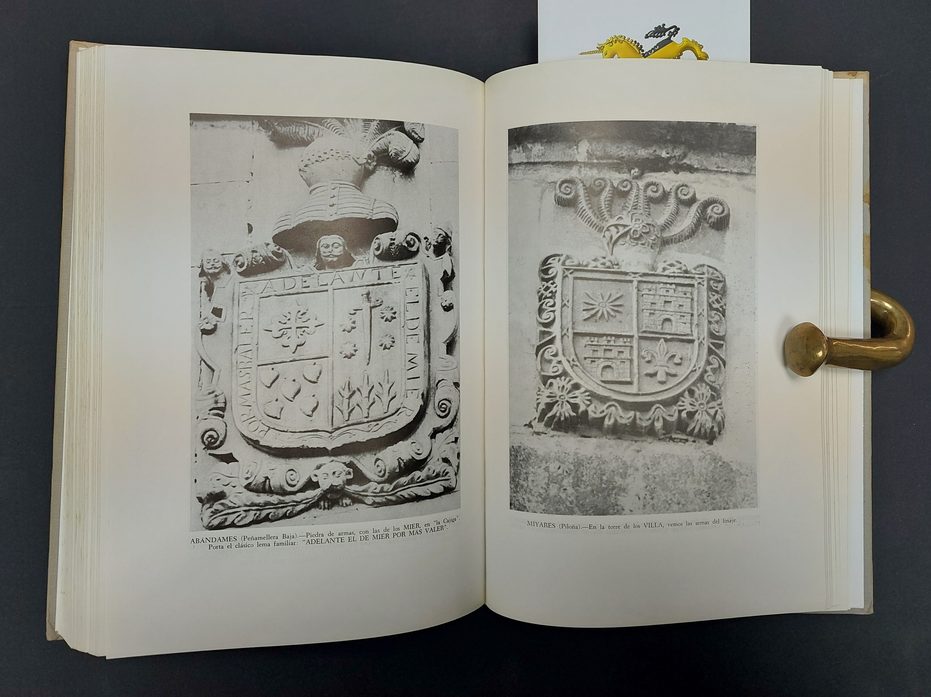Century XX


![Ver [Académie internationale d'héraldique; 1999] en referencias bibliográficas. Libro abierto, hojas de plata, filo de oro, guardas de gules, tapas de sable.](../css/Libro.Bibliografia.png)
Académie internationale d'héraldique; 1999
Académie internationale d'héraldique, AIH, «Mémorial du Jubilé, 1949-1999», 201 páginas, 1999.
Bibliographical reference of century XX.
Classification: Report and French language.
Author: Académie internationale d'héraldique.
The following article cites this bibliographic reference:
External resource:
Internal resources: Aih1999.Memorial.pdf.


![Ver [Adams, A.; 1941] en referencias bibliográficas. Libro abierto, hojas de plata, filo de oro, guardas de gules, tapas de sable.](../css/Libro.Bibliografia.png)
Adams, A.; 1941
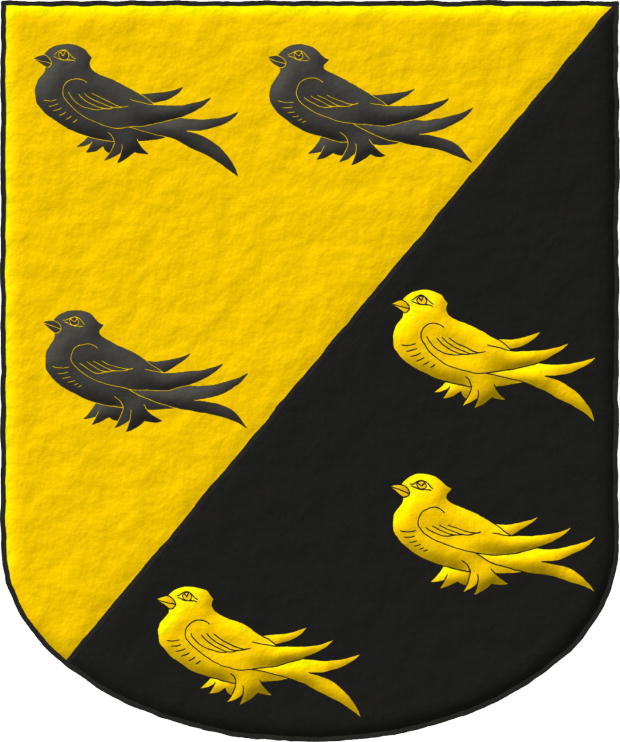
Arthur Adams, PhD, F. S. A., «Cheshire Visitation Pedigrees, 1663», 141 pages, edited by J. Whitehead and Son Limited, series Publications of the Harleian Society, volume 93, London, 1941.
This book includes some illustrations, but in black and white. The coat of arms that illustrates this bibliographic reference is a color interpretation of one of those recorded in this book, based on the recreations by Martin S. J. Goldstraw. It specifically corresponds to the coat of arms of Allen de Brindley, with the difference that here its crest is not included.
Bibliographical reference of century XX.
Author: Adams, Arthur.


![Ver [Ailes, A.; 1982] en referencias bibliográficas. Libro abierto, hojas de plata, filo de oro, guardas de gules, tapas de sable.](../css/Libro.Bibliografia.png)
Ailes, A.; 1982
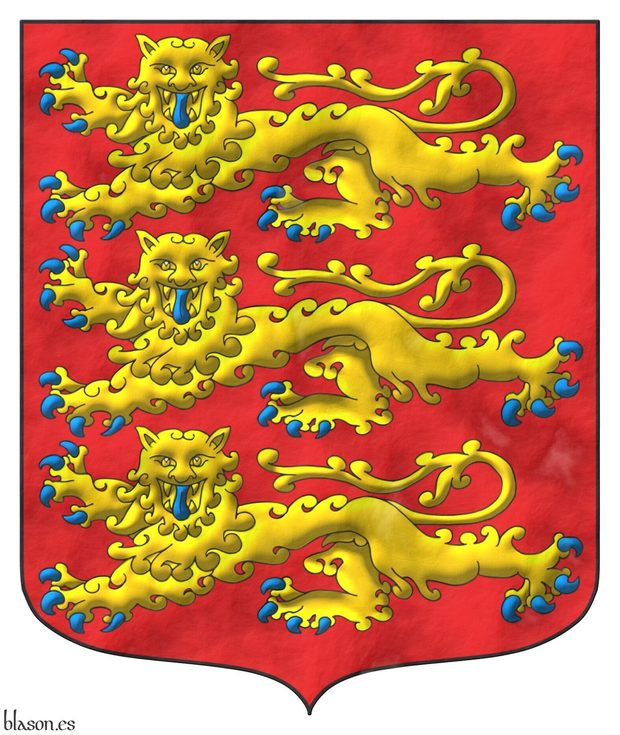
Adrian Ailes, «The Origins of the Royal Arms of England: Their Development to 1199», foreword by Rodney Dennys, includes 27 black and white illustrations, Graduate Centre for Medieval Studies, Reading University, 126 pages, ISBN 07-049077-6-3, Reading, Berkshire, 1982.
An article reviewing this book is: Brigitte Bedos Rezak, Archives nationales de Paris and Metropolitan Museum of Art, «The Origins of the Royal Arms of England, their Development to 1199 by Adrian Ailes», Speculum, volume 60, number 2, pages 373-376, Medieval Academy of America, Cambridge, Massachusetts, April of 1985.
Bibliographical reference of century XX.
Author: Ailes, Adrian.
The following article cites this bibliographic reference:
External resource:


![Ver [Arco y García, F. del; 1996a] en referencias bibliográficas. Libro abierto, hojas de plata, filo de oro, guardas de gules, tapas de sable.](../css/Libro.Bibliografia.png)
Arco y García, F. del; 1996a
Fernando del Arco y García, «Introducción a la Heráldica», 142 pages, Collection Burgundy Pursuivant, edited by Prensa y Ediciones Iberoamericanas SL, printed by Gráficas Joma, Legal deposit M-5240, ISBN 84-86568-64-1, Madrid, 22nd of february of 1996.
In the image, you can see two pages of this book regarding his criteria on the war cry, the motto, and the legend. These criteria do not align with mine, as I follow [Sevilla Gómez, A.; 2000] and describe in Lema, divisa, mote y grito de guerra.
Bibliographical reference of century XX.
Classification: De bibliotheca, In black and white and Castilian language.
The author is Arco y García, Fernando del.
The following article cites this bibliographic reference:
Internal resources: Physical book on paper.


![Ver [Arco y García, F. del; 1996b] en referencias bibliográficas. Libro abierto, hojas de plata, filo de oro, guardas de gules, tapas de sable.](../css/Libro.Bibliografia.png)
Arco y García, F. del; 1996b
Fernando del Arco y García, «Método de blasonar», 75 pages, Perseverant Burgundy Collection, edited by Ateneist Group of Vexilological, Heraldic and Genealogical Studies, printed by Gráficas Joma, Legal deposit M. M-5240, ISBN 84-606-2768-3, Madrid, 1996.
Bibliographical reference of century XX.
Classification: De bibliotheca, In black and white and Castilian language.
Author: Arco y García, Fernando del.
Bibliographical reference mentioned in the following article:
Internal resources: Physical book on paper.


![Ver [Armytage, G. J.; Rylands, J. P.; 1909] en referencias bibliográficas. Libro abierto, hojas de plata, filo de oro, guardas de gules, tapas de sable.](../css/Libro.Bibliografia.png)
Armytage, G. J.; Rylands, J. P.; 1909
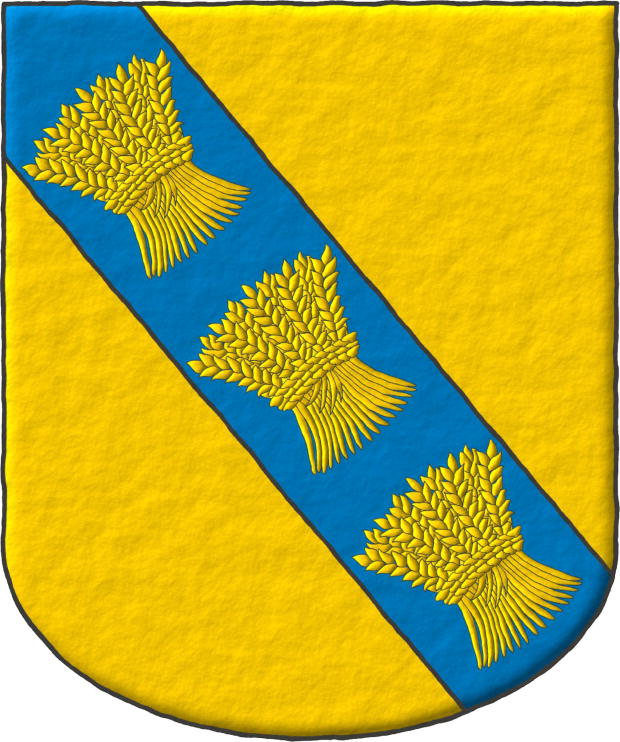
George J. Armytage and John Paul Rylands, «Pedigrees Made at the Visitation of Cheshire, 1613, taken by Richard Saint George, Esq., Norroy King of Arms and Henry Saint George, Gent., Bluemantle Pursuivant of Arms; and some other contemporary pedigrees», edited by Sir George J. Armytage, Bart., F. S. A. and John Paul Rylands, Esq., F. S. A., published by Mitchell, Hughes & Clark, printed for The Record Society, London, 1909.
[Goldstraw, M. S. J.; 2013b] is a color recreation of the coats of arms recorded in this book.
The coat of arms that illustrates this bibliographic reference is one of those recorded in this book, which contains only a few illustrations in black and white, and corresponds to the coat of arms of Fitton de Carden, Clutton y Chester.
Bibliographical reference of century XX.
The 2 authors are Armytage, George J. and Rylands, John Paul.
Bibliographical reference mentioned in the following article:


![Ver [Atienza y Navajas, J. de; 1959] en referencias bibliográficas. Libro abierto, hojas de plata, filo de oro, guardas de gules, tapas de sable.](../css/Libro.Bibliografia.png)
Atienza y Navajas, J. de; 1959
Julio de Atienza y Navajas, Baron of the Cobos de Belchite, «Nobiliario Español: Diccionario Heráldico de Apellidos y Títulos», 1st edition, edited by Aguilar, 1,712 pages, 2 volumes, Madrid, 1959.
It is a monumental work that includes a heraldic dictionary and blazons of Spanish lineages and noble titles, along with the history and genealogy of thousands of Spanish families.
Bibliographical reference of century XX.
Classification: Castilian language, In black and white and De bibliotheca.
Author: Atienza y Navajas, Julio de.
The following article cites this bibliographic reference:
Internal resources: Physical book on paper, 2 volumes.


![Ver [Becher, C.; Gamber, O.; 1986] en referencias bibliográficas. Libro abierto, hojas de plata, filo de oro, guardas de gules, tapas de sable.](../css/Libro.Bibliografia.png)
Becher, C.; Gamber, O.; 1986
Charlotte Becher and Ortwin Gamber, «Die Wappenbücher Herzog Albrechts VI. von Österreich: Ingeram-Codex der ehem, Bibliothek Cotta, Volume 1», editado por Böhlau Verlag Wien, 178 pages, ISBN 3-205-05002-9 y 978-32-05050-02-5, Vienna, Cologne, Graz, 1986.
Dedicated exclusively to the study and analysis of the armorial [Ingeram, H.; 1459].
Bibliographical reference of century XX.
Classification: German language, Manuscript, Armorial roll and In color.
Authors: Becher, Charlotte and Gamber, Ortwin.
Bibliographical reference mentioned in the following article:
External link:


![Ver [Brault, G. J.; 1997] en referencias bibliográficas. Libro abierto, hojas de plata, filo de oro, guardas de gules, tapas de sable.](../css/Libro.Bibliografia.png)
Brault, G. J.; 1997
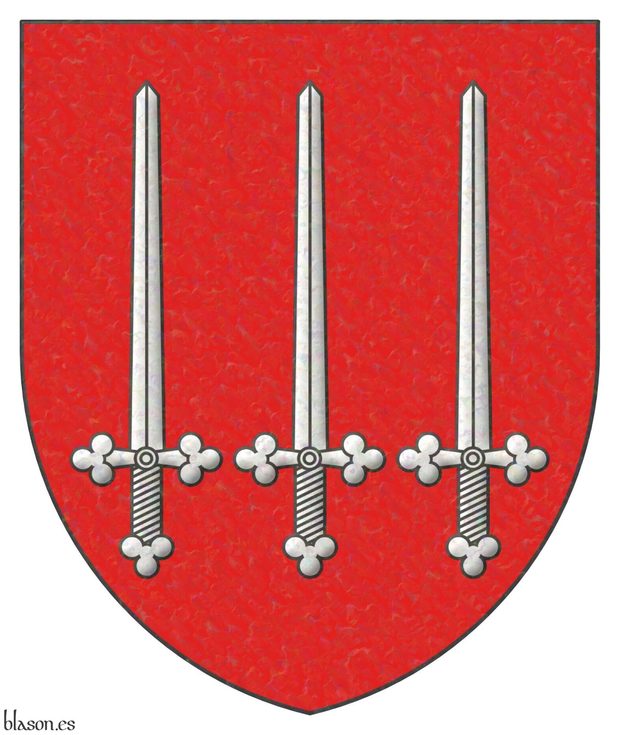
Gerard J. Brault, professor of French and Medieval Studies at Pennsylvania State University, «Rolls of Arms of Edward I, 1272-1307, Volume I and Volume II», is a set of 2 volumes, 1,104 pages, size 24.4 x 17.2 cm, with 3 color illustrations and 8 black and white illustrations, published by Boydell Press, Aspilogia series, ISBN 9780851156699, Suffolk, United Kingdom, May 1, 1997.
Another annotated edition exists from February 21, 2008, also published by Boydell Press.
The starting hypothesis of this book is that at the beginning of the second half of the 13th century, the use of coats of arms increased, this increase led to the appearance of the first armorials in which the names of their holders were recorded along with the descriptive blazon of their armory, and painted shields could be included.
From the Middle Ages, about 350 armorials have survived, of which 130 come from England, and they are a unique source for identifying many medieval figures, their titles, and their possessions. This book analyzes 17 of these armorials, such as the so-called [Marshal, L.; 1295; The Lord Marshal's Roll], which includes the coat of arms of William de Colebrand that illustrates this bibliographic reference.
Bibliographical reference of century XX.
The author is Brault, Gerard J..
The following articles cite this bibliographic reference:
External resource:


![Ver [Bravo Guarida, C.; 1934] en referencias bibliográficas. Libro abierto, hojas de plata, filo de oro, guardas de gules, tapas de sable.](../css/Libro.Bibliografia.png)
Bravo Guarida, C.; 1934
Clemente Bravo Guarida, «El Paso Honroso de Don Suero de Quiñones: Célebre Caballero Leonés en el Puente de Órbigo, en 1434», second edition, published by «El Diario de León» to commemorate the fifth centenary of this famous feat of arms, 59 pages, printed by Imprenta Católica, León, 1934.
This edition, written by Clemente Bravo Guarida, provides an updated account of the famous «Passo Honroso», [Rodríguez de Lena, P.; Century XVI], undertaken by the renowned knight Suero de Quiñones in 1434 at the bridge of Órbigo.
The book includes the full list of the 10 maintainers on page 57, and the 68 challengers, or adventurers, on pages 67 and 68. It also reports the results of the jousts for all participants.
Please note a correction: on page 58, where it reads «Loque de la Torre, corrió 6, rompió 4» it should instead say «Lope de la Torre, corrió 6, rompió 4».
Bibliographical reference of century XX.
Classification: Castilian language and In black and white.
Author: Bravo Guarida, Clemente.
The following article cites this bibliographic reference:
Internal resources: BravoGuaridaC1934.PasoHonroso.Ocr.pdf.


![Ver [Burke, B.; 1989] en referencias bibliográficas. Libro abierto, hojas de plata, filo de oro, guardas de gules, tapas de sable.](../css/Libro.Bibliografia.png)
Burke, B.; 1989
Sir Bernard Burke, C. B., LL. D., Ulster King of Arms, «The General Armory of England, Scotland, Ireland and Wales; Comprising a Registry of Armorial Bearings from the Earliest to the Present Time», edited by Heraldry Today, printed by Redwoods Books, 1185 pages and an initial supplement with 130 pages, Trowbridge, Wiltshire, 1989.
Its first edition was [Burke, B.; 1842].
Bibliographical reference of century XX.
Classification: In black and white and English language.
The author is Burke, Bernard.
The following articles cite this bibliographic reference:
Internal resources: Paper edition.


![Ver [Cadenas y Vicent, V. de; 1975] en referencias bibliográficas. Libro abierto, hojas de plata, filo de oro, guardas de gules, tapas de sable.](../css/Libro.Bibliografia.png)
Cadenas y Vicent, V. de; 1975
Vicente de Cadenas y Vicent, Dean King of Arms, «Fundamentos de Heráldica (Ciencia del Blasón)», Instituto Salazar Castro (C. S. I. C. Higher Center for Scientific Research), edited by Ediciones Hidalguía, 212 pages, Madrid, 1975.
Bibliographical reference of century XX.
Classification: In black and white.
The author is Cadenas y Vicent, Vicente de.
Here are the articles quoting this reference:
- Fernando Marán Bié, The Armorial Register
- Governance heraldry
- Holy Trinity
- Military heraldry
- Personal Heraldry
- Pile issuant from the base in the Dictionary of the Spanish Language
- Religious heraldry
- Socioeconomic heraldry
- Supporter
External link:


![Ver [Cadenas y Vicent, V. de; 1987] en referencias bibliográficas. Libro abierto, hojas de plata, filo de oro, guardas de gules, tapas de sable.](../css/Libro.Bibliografia.png)
Cadenas y Vicent, V. de; 1987
Vicente de Cadenas y Vicent, Dean King of Arms, «Repertorio de blasones de la comunidad hispánica», Instituto Salazar Castro (C. S. I. C. Higher Center for Scientific Research), edited by Ediciones Hidalguía, printed by Gráficas Arias Montano, S. A., Móstoles, 2nd edition, ISBN of the complete work 84-00-06642-1, Legal deposit of the complete work M.31.950-1987, Madrid, 1987.
4 volumes and 1 apendix
- Volume I, contains the surnames that begin with the letters A, B, C & CH, and ISBN of this volume I 84-00-06643-X.
- Volume II, contains the surnames that begin with the letters D, E, F, G, H, I, J, K, L & LL, and ISBN of this volume II 84-00-06044-8.
- Volume III, contains the surnames that begin with the letters M, N, Ñ, O, P, Q & R, and ISBN of this volume III 84-00-06645-6.
- Volume IV, contains the surnames that begin with the letters S, T, U, V, W, X, Y & Z, and ISBN of this volume IV 84-00-06646-4.
- Apendix I, contains other surnames not included in the previous volumes, and ISBN of this apendix I I 84-00-05912-3.
Example, Uranzu in the volume VI
The volume IV has 454 pages numbered from 1525 to 1979. This is my translation for the 4th coat of arms of the 5 blazons of surname «Uranzu» described on pages 1,726 and 1,728 of this volume IV (see in the previous image of the original blazon).
Party per pale:
1 Gules,
the base,
wavy Argent and Azure, on them,
a Galleon with eight Cannons per band,
nine Galleys,
seven Galiots,
five Fustas, and
a Brigantine sailing,
the Ships, their Masts and Strings all Or,
the Galleon with Sails Argent,
the other Ships with Sails lowered Argent,
in chief,
an imperial eagle Sable, flying towards the galleon;
2 Argent,
a lion rampant Gules,
with its rear Paws on an Anchor Azure
lying to the sinister Flank,
holding in its fore Paws a Flagpole Vert with
three Flags,
Azure, three Fleurs de lis Or, ordered,
Azure, two Bends Or,
Gules, a plain Cross Argent,
between
four smalls Anchors Sable with Cables Gules.
Within a Bordure Or, sixteen Saltires Gules.
Although I am not sure of the reality of this coat of arms, I have made a) in Spanish a simplification and b) its translation in parallel to English. I assume that in the 2nd flag the Fleurs de lis in triangle are 3 and they are ordered. Although I am not sure of the reality of this busy coat of arms, I can't found a painted version, I have made a) a simplification of its Spanish blazon and b) its translation in parallel to English. I assume that in the 2nd flag the Fleurs de lis in triangle are 3 and they are ordered. The colors of the text in the images lets an easy reading and show the blazon structure. There are in this coat of arms 1+9+7+5+1 = 23 ships.
Currently the National Institute of Statistics of Spain (I. N. E.), about the surname «Uranzu» answer that «there are no inhabitants with the surname consulted», neither 1st nor 2nd surname, «or its frequency is less than 5 for the national total».
Bibliographical reference of century XX.
Classification: Black and white with color plates.
Author: Cadenas y Vicent, Vicente de.
Here are the articles quoting this reference:
- Albero, lineage of Aragon
- Argüello of Extremadura, lineage
- Burr, lineage
- Egado, lineage
- Gangoiti, lineage
- Laydin, lineage
- Lozengy 5x6 and 6x7
- Osona, lineage
- Pile issuant from the base in the Dictionary of the Spanish Language
- Poumola, lineage of Catalonia
External links:


![Ver [Chaparro D'Acosta L.; 1979] en referencias bibliográficas. Libro abierto, hojas de plata, filo de oro, guardas de gules, tapas de sable.](../css/Libro.Bibliografia.png)
Chaparro D'Acosta L.; 1979
Lino Chaparro D'Acosta, «Heráldica de los Apellidos Canarios», foreword by Vicente de Cadenas y Vicent, 2 volumes, Volume I from A to L, 285 surnames, 293 pages, Volume II from M to Z and a heraldic dictionary, 387 surnames, 439 pages, edited by Estudios Tecnicos del Blason, ISBN of the complete work 84-300-2000-4, ISBN of Volume I 84-300-1989-8, ISBN of Volume I II 84-300-418010-8, Las Palmas de Gran Canaria, 1979.
Bibliographical reference of century XX.
Classification: Black and white with color plates and Castilian language.
The author is Chaparro D'Acosta, Lino.
The following article cites this bibliographic reference:


![Ver [Cramer, R. de; 1913] en referencias bibliográficas. Libro abierto, hojas de plata, filo de oro, guardas de gules, tapas de sable.](../css/Libro.Bibliografia.png)
Cramer, R. de; 1913
René de Cramer, «Drapeaux, Bannières, Vlaggen en Wimpels», Universal and International Exhibition of Ghent 1913, La Vieille Flandre, published by Société Anonyme Belge d'Imprimerie, Brussels, 1913.
Bibliographical reference of century XX.
Classification: French language, Dutch language and Black and white with color plates.
Author: Cramer, René de.
Internal resources: CramerRde913.DrapeauxBannir.docx.


![Ver [Cuena Bartolomé, J.; 1968] en referencias bibliográficas. Libro abierto, hojas de plata, filo de oro, guardas de gules, tapas de sable.](../css/Libro.Bibliografia.png)
Cuena Bartolomé, J.; 1968
José Cuena Bartolomé, Doctor of Civil Engineering (Roads, Canals and Harbours) of the Computing Office of the Center for Studies and Experimentation of Public Works, «The ordered trial of solutions in hydraulic systems by means of mathematical simulation models on an electronic computer» Journal of «Obras Públicas» del College of Roads, Canals and Harbours, 115, volume I, number 3038, pages 413-430, ISSN 0034-8619, ISSN electronic 1695-4408, Legal Deposit M-156-1958, Madrid, June 1968.
Bibliographical reference of century XX.
Classification: Magazine and Castilian language.
The author is José Cuena Bartolomé.
Bibliographical reference mentioned in the following article:

![Ver [Durasov, V. A.; 1906] en referencias bibliográficas. Libro abierto, hojas de plata, filo de oro, guardas de gules, tapas de sable.](../css/Libro.Bibliografia.png)
Durasov, V. A.; 1906
Vladimir Alexandrovich Durasov, «Heráldica de la Nobleza de toda Rusia», 279 páginas, San Petersburgo, 1906.
Descripción
Esta obra, escrita por V. A. Durasov, es un registro heráldico completo de la nobleza rusa. Proporciona ilustraciones de los escudos de armas de las familias nobles a lo largo del Imperio Ruso.
El nombre completo del autor es Vladimir Alexandrovich Durasov, aunque en algunas fuentes, especialmente en versiones traducidas o abreviadas, puede aparecer como «W. Durasov» debido a problemas comunes de transliteración del ruso al alfabeto latino.
La obra se cita comúnmente como publicada en 1906, según se indica al inicio del libro; sin embargo, la fecha en la última página del libro es 1907.
Bibliographical reference of century XX.
Classification: Armorial roll, Russian language and Black and white with color plates.
The author is Durasov, Vladimir Alexandrovich.
Internal resources: DurasovVA1906.HeraldicaNoblezaRusa.pdf Formato PDF.


![Ver [Emblemata; 1995] en referencias bibliográficas. Libro abierto, hojas de plata, filo de oro, guardas de gules, tapas de sable.](../css/Libro.Bibliografia.png)
Emblemata; 1995
Baron of Valdeolivos Emblematic Chair, of the Fernando el Catolico Institution, of the Centre of Scientific Research (C. S. I. C.) and of the Government of Zaragoza, «Emblemata», Volume 1st, Emblemata Aragonese Magazine about Emblems (E. R. A. E.), 419 pages, 44 pictures, ISSN 1137-1056, Legal deposit Z.3.937 1996, printed by the Cooperativa de Artes Gráficas Librería General, Zaragoza, 1995.
Bibliographical reference of century XX.
Classification: Magazine and Castilian language.
The author is Cátedra de Emblemática Barón de Valdeolivos.
External resource:


![Ver [Emblemata; 1996] en referencias bibliográficas. Libro abierto, hojas de plata, filo de oro, guardas de gules, tapas de sable.](../css/Libro.Bibliografia.png)
Emblemata; 1996
Baron of Valdeolivos Emblematic Chair, of the Fernando el Catolico Institution, of the Centre of Scientific Research (C. S. I. C.) and of the Government of Zaragoza, «Emblemata», Volume 2nd, Emblemata Aragonese Magazine about Emblems (E. R. A. E.), 396 pages, 89 pictures, ISSN 1137-1056, Legal deposit Z.3.937 1996, printed by the Cooperativa de Artes Gráficas Librería General, Zaragoza, 1996.
Bibliographical reference of century XX.
Classification: Magazine and Castilian language.
Author: Cátedra de Emblemática Barón de Valdeolivos.
External resource:


![Ver [Emblemata; 1997] en referencias bibliográficas. Libro abierto, hojas de plata, filo de oro, guardas de gules, tapas de sable.](../css/Libro.Bibliografia.png)
Emblemata; 1997
Baron of Valdeolivos Emblematic Chair, of the Fernando el Catolico Institution, of the Centre of Scientific Research (C. S. I. C.) and of the Government of Zaragoza, «Emblemata», Volume 3rd, Emblemata Aragonese Magazine about Emblems (E. R. A. E.), 480 pages, 116 pictures, 2 maps, ISSN 1137-1056, Legal deposit Z.3.937 1996, printed by the Cooperativa de Artes Gráficas Librería General, Zaragoza, 1997.
Bibliographical reference of century XX.
Classification: Magazine and Castilian language.
The author is Cátedra de Emblemática Barón de Valdeolivos.
External link:


![Ver [Emblemata; 1998] en referencias bibliográficas. Libro abierto, hojas de plata, filo de oro, guardas de gules, tapas de sable.](../css/Libro.Bibliografia.png)
Emblemata; 1998
Baron of Valdeolivos Emblematic Chair, of the Fernando el Catolico Institution, of the Centre of Scientific Research (C. S. I. C.) and of the Government of Zaragoza, «Emblemata», Volume 4th, Emblemata Aragonese Magazine about Emblems (E. R. A. E.), 450 pages, 135 pictures, ISSN 1137-1056, Legal deposit Z.3.937 1996, printed by the Cooperativa de Artes Gráficas Librería General, Zaragoza, 1998.
Bibliographical reference of century XX.
Classification: Magazine and Castilian language.
Author: Cátedra de Emblemática Barón de Valdeolivos.
External resource:


![Ver [Emblemata; 1999] en referencias bibliográficas. Libro abierto, hojas de plata, filo de oro, guardas de gules, tapas de sable.](../css/Libro.Bibliografia.png)
Emblemata; 1999
Baron of Valdeolivos Emblematic Chair, of the Fernando el Catolico Institution, of the Centre of Scientific Research (C. S. I. C.) and of the Government of Zaragoza, «Emblemata», Volume 5th, Emblemata Aragonese Magazine about Emblems (E. R. A. E.), 484 pages, 124 pictures, ISSN 1137-1056, Legal deposit Z.3.937 1996, printed by the Cooperativa de Artes Gráficas Librería General, Zaragoza, 1999.
Bibliographical reference of century XX.
Classification: Magazine and Castilian language.
The author is Cátedra de Emblemática Barón de Valdeolivos.
External link:


![Ver [Emblemata; 2000] en referencias bibliográficas. Libro abierto, hojas de plata, filo de oro, guardas de gules, tapas de sable.](../css/Libro.Bibliografia.png)
Emblemata; 2000
Baron of Valdeolivos Emblematic Chair, of the Fernando el Catolico Institution, of the Centre of Scientific Research (C. S. I. C.) and of the Government of Zaragoza, «Emblemata», Volume 6th, Emblemata Aragonese Magazine about Emblems (E. R. A. E.), 419 pages, 124 pictures, ISSN 1137-1056, Legal deposit Z.3.937 1996, printed by the Cooperativa de Artes Gráficas Librería General, Zaragoza, 2000.
Bibliographical reference of century XX.
Classification: Magazine and Castilian language.
The author is Cátedra de Emblemática Barón de Valdeolivos.
External resources:
Internal resources: Emblemata2000.Volumen06.pdf.


![Ver [Ferrer i Vives, F.; 1995] en referencias bibliográficas. Libro abierto, hojas de plata, filo de oro, guardas de gules, tapas de sable.](../css/Libro.Bibliografia.png)
Ferrer i Vives, F.; 1995
Francesc d'A Ferrer i Vives, «Heraldica Catalana», 3 volumes, Volume I A-F, Volume II G-P, Volume III Q-Z, ISBN of the complete work 84-7304-204-2, Legal Deposit B.20.464 - april 1995, Editorial Milla, Carrer de Sant Pau 21, Barcelona, 1995.
Bibliographical reference of century XX.
Classification: Catalan language and In black and white.
Author: Ferrer i Vives, Francesc d'A.
Bibliographical reference mentioned in the following article:
Internal resources: Paper book.


![Ver [Finas, F.; 1950] en referencias bibliográficas. Libro abierto, hojas de plata, filo de oro, guardas de gules, tapas de sable.](../css/Libro.Bibliografia.png)
Finas, F.; 1950
Fromageries Finas, «Collection des blasons de France. 1st Edition», «Collection des blasons de France. 2nd Edition», 23 pages, illustrated by Jean Brian, cover signed by R. Assier, published by Fromageries Finas, Saint-Félix, Haute-Savoie, circa 1950.
The «Collection des blasons de France» collections include two editions: the first edition with 50 coats of arms from French provinces and the second edition with 100 coats of arms from the main cities of France.
Each coat of arms was included in the packaging of Finas spreadable cheeses. The albums were available upon request for 10 postage stamps to cover handling costs.
These albums are an excellent example of how brands used heraldry to create an emotional and educational connection with their customers, employing coats of arms to reinforce a sense of identity and tradition, as can be seen in the index of the 1st edition.
Index of the 1st edition, coat of arms and page:
- Alsace 8
- Angoumois 12
- Anjou 10
- Armagnac 14
- Artois 4
- Aunis 12
- Auvergne 16
- Bar 8
- Béarn 14
- Beaujolais 6
- Berry 12
- Bourbonnais 6
- Bourgogne 6
- Bresse 6
- Bretagne 10
- Champagne 8
- Charolais 6
- Comtat-Venaissin 18
- Corse 18
- Dauphiné 18
- Flandre 4
- Foix 14
- Forez 16
- Franche-Comté 8
- Gascogne 14
- Guyenne 14
- Ile-de-France 4
- Languedoc 16
- Limousin 12
- Lorraine 8
- Lyonnais 6
- Maine 10
- Marche 12
- Maurienne 18
- Navarre 14
- Nice 18
- Nivernais 6
- Normandie 10
- Orléanais 10
- Picardie 4
- Poitou 12
- Provence 18
- Quercy 14
- Roussillon 16
- Saintonge 12
- Savoie 18
- Touraine 10
- Valois 4
- Vermandois 4
- Vivarais 16
Bibliographical reference of century XX.
Classification: Armorial roll, French language and In color.
Author: Finas, Fromageries.
Internal resources: FinasF1950.01.Edition.pdf Digital PDF version of the 1st Edition and FinasF1950.02.Edition.pdf Digital PDF version of the 2nd Edition.


![Ver [Fox-Davies, A. C.; 1909] en referencias bibliográficas. Libro abierto, hojas de plata, filo de oro, guardas de gules, tapas de sable.](../css/Libro.Bibliografia.png)
Fox-Davies, A. C.; 1909
Arthur Charles Fox-Davies of Lincoln's Inn, Barrister-at-Law, «A Complete Guide to Heraldry», author of «The Art of Heraldry», illustrated by nine plates in colour and nearly 800 other designs, mainly from drawings by Graham Johnston, Herald Painter to the Lyon Court, edited by T. C. & E. C. Jack, 16 Henrietta Street, W.C., and Edinburgh, editor of «Armorial Families», London, 1909.
Bibliographical reference of century XX.
Classification: De bibliotheca, In black and white and English language.
The author is Fox-Davies, Arthur Charles.
Bibliographic reference mentioned in the following articles:
- Coat of arms of Alena Rehberger
- Design with a fess between 4 water-bougets
- Lloscós y Soldevilla, Guilaberto
- South Clifton, Lord of
Internal resources: FoxDaviesAC1909.CompleteGuideToHeraldry.712pages.pdf in PDF format 712 pages, FoxDaviesAC1909.CompleteGuideToHeraldry.387pages.pdf in PDF format 387 pages, FoxDaviesAC1909.CompleteGuideToHeraldry.353pages.pdf in PDF format 353 pages, FoxDaviesAC1909.CompleteGuideToHeraldry.epub in ePub format and Physical book on paper.


![Ver [Friar, S.; 1987] en referencias bibliográficas. Libro abierto, hojas de plata, filo de oro, guardas de gules, tapas de sable.](../css/Libro.Bibliografia.png)
Friar, S.; 1987
Stephen Friar, «A Dictionary of Heraldry», first edition, illustrated by John Ferguson, Andrew Jamieson, and Anthony Wood, 384 pages, Harmony Books, ISBN.10 0-517-56665-6, New York, 1987.
This book is a comprehensive dictionary that explains the meanings of many heraldic symbols and discusses aspects of the history of heraldry. Stephen Friar, Director of The Society of Heraldic Arts, compiled this work with contributions from renowned heraldic illustrators. It is a valuable resource for anyone interested in heraldry, providing detailed descriptions and illustrations of heraldic terms and symbols.
Bibliographical reference of century XX.
Classification: Dictionary, English language and In color.
The author is Friar, Stephen.
The following articles cite this bibliographic reference:


![Ver [García Carraffa, A.; García Carraffa, A.; 1920] en referencias bibliográficas. Libro abierto, hojas de plata, filo de oro, guardas de gules, tapas de sable.](../css/Libro.Bibliografia.png)
García Carraffa, A.; García Carraffa, A.; 1920
Alberto García Carraffa y Arturo García Carraffa, «Heraldic and Genealogical Dictionary of Spanish and American Surnames», 88 volumes, printed by Antonio Marzo, Madrid, 1920.
Contents of the 88 volumes
- Volume I. The science of heraldry or blazon.
- Volume II. Dictionary of blazonry terms; Methods of blazoning; Index of heraldic.
- Volume III. Aanda - Adan de Yarza.
- Volume IV. Adana - Aich.
- Volume V. Aichiaivoli - Alcocer.
- Volume VI. Alcoces - Almuzara.
- Volume VII. Aloi - Alzuru.
- Volume VIII. Allado - Anés.
- Volume IX. Anescar - Aragón.
- Volume X. Aragonés - Arecha.
- Volume XI. Aréchaga - Aronal.
- Volume XII. Aronsena - Azzia.
- Volume XIII. Baana - Barbena.
- Volume XIV. Barbens - Basani.
- Volume XV. Basanta - Benavides.
- Volume XVI. Bencarza - Blancazo.
- Volume XVII. Blanco - Bolet.
- Volume XVIII. Boliaga - Brañas.
- Volume XIX. Braramuño - Buzón.
- Volume XX. Caamaño - Cadelo.
- Volume XXI. Cadena - Campani.
- Volume XXII. Campano - Cañellas.
- Volume XXIII. Cañete - Caroli.
- Volume XXIV. Carondelet - Cassador.
- Volume XXV. Castant - Celaeta.
- Volume XXVI. Celain - Claver.
- Volume XXVII. Claveria - Cutuneguieta.
- Volume XXVIII. Chavelas - Desportell.
- Volume XXIX. Despou - Duzay.
- Volume XXX. Ebazquin - Ellauri.
- Volume XXXI. Ellul - Escolonea.
- Volume XXXII. Escorcia - Ezterripa.
- Volume XXXIII. Fabalis - Fernández de Espinosa.
- Volume XXXIV. Fernández de Estenoz - Figuereido.
- Volume XXXV. Figuera - Franco.
- Volume XXXVI. Francoli - Gamboa.
- Volume XXXVII. Gambacorta - García de la Plata.
- Volume XXXVIII. García y Portilla - Gil de Zúñiga.
- Volume XXXIX. Gilabert - Gómez de la Serna.
- Volume XL. Gómez de Silva - Gorriti.
- Volume XLI. Górriz - Guil.
- Volume XLII. Guilisagasti - Haro.
- Volume XLIII. Hartos - Hilera.
- Volume XLIV. Hilgueros - Ibarrundia.
- Volume XLV. Ibars de Povil - Irazusta.
- Volume XLVI. Irgas - Izurzu.
- Volume XLVII. Jabaloyas - Juyá.
- Volume XLVIII. Labaca - Larburu.
- Volume XLIX. Lardíes - Lazcamburu.
- Volume L. Lazcano - Lizárraga.
- Volume LI. Lizarralde - Luzuriaga.
- Volume LII. Llabiá - Malda.
- Volume LIII. Maldonado - Marín.
- Volume LIV. Marina - Marroquin.
- Volume LV. Marrubiza - Mendibure.
- Volume LVI. Mendicoa - Mesares.
- Volume LVII. Mescua - Moncayo.
- Volume LVIII. Monclares - Moradell.
- Volume LIX. Moraga - Mozo.
- Volume LX. Mozo de la Torre - Muzúa.
- Volume LXI. Naarruza - Nelia.
- Volume LXII. Neira - Ocaranza.
- Volume LXIII. Ocariz - Olcina.
- Volume LXIV. Olcinellas - Ordines.
- Volume LXV. Ordonias - Oruna.
- Volume LXVI. Oruña - Ozticain.
- Volume LXVII. Pablo or de Pablo - Palandegui or Palantegui.
- Volume LXVIII. Palafurgell - Parro.
- Volume LXIX. Parrondo - Pellón.
- Volume LXX. Pemán - Pérez de Arramendia.
- Volume LXXI. Pérez de Arroyo - Pillado.
- Volume LXXII. Pimentel - Poli.
- Volume LXXIII. Polo - Portero.
- Volume LXXIV. Portes - Puig - Gat.
- Volume LXXV. Puigbaco - Quincoces.
- Volume LXXVI. Quinquer - Rami.
- Volume LXXVII. Ramírez - Rezusta.
- Volume LXXVIII. Riabeyo - Rizo.
- Volume LXXIX. Roa - Romaza.
- Volume LXXX. Romero or Romeo, O Romeu - Ruy de Peras.
- Volume LXXXI. Sáa - Salinas.
- Volume LXXXII. Sall - Santángel or Sant Angel.
- Volume LXXXIII. Santaolaria or Santolaria - Sayola.
- Volume LXXXIV. Sebastián - Sirtema.
- Volume LXXXV. Sirvent or Sirvente - Susunaga.
- Volume LXXXVI. Tabar or Tavar - Tolosans.
- Volume LXXXVII. Tolrá - Tutor.
- Volume LXXXVIII. Uacué - Urriza.
Bibliographical reference of century XX.
Classification: Castilian language and Black and white with color plates.
Authors: García Carraffa, Alberto and García Carraffa, Arturo.
External resources:
Internal resources: GarciaCarrafiaAyA1920.Tomo.01.pdf PDF format, GarciaCarrafiaAyA1920.Tomo.04.pdf PDF format and GarciaCarrafiaAyA1920.Tomo.08.pdf PDF format.


![Ver [García Carraffa, A.; García Carraffa, A.; 1968] en referencias bibliográficas. Libro abierto, hojas de plata, filo de oro, guardas de gules, tapas de sable.](../css/Libro.Bibliografia.png)
García Carraffa, A.; García Carraffa, A.; 1968
Alberto García Carraffa y Arturo García Carraffa, with the colaboration of Armando de Fluviá y Escorsa, «El Solar Catalán, Valenciano y Balear», 4 volumes, Volume I Abad-Cebrián, 443 pages, Volume II Celma-Malda, 449 pages, Volume III Malendric-Quirant, 425 pages, Volume IV Rabasa-Zenarbe y apéndice, 516 pages, 1st edition, Heraldic Collection, edited by Librería Internacional, San Sebastián, 1968.
Bibliographical reference of century XX.
Classification: Castilian language and Black and white with color plates.
The 2 authors are García Carraffa, Alberto and García Carraffa, Arturo.
Bibliographic reference mentioned in the following articles:
Internal resources: Paper book.

![Ver [GDLC; 1998] en referencias bibliográficas. Libro abierto, hojas de plata, filo de oro, guardas de gules, tapas de sable.](../css/Libro.Bibliografia.png)
GDLC; 1998
Various authors, «Gran diccionari de la llengua catalana», known as GDLC, Enciclopèdia Catalana, Diccionaris de l’Enciclopèdia, ISBN 84-412-2790-X Barcelona, 1998.
Bibliographical reference of century XX.
Classification: Dictionary and Catalan language.
The author is Various authors.
The following article cites this bibliographic reference:
External resource:


![Ver [González Echegaray, M. C.; 1969] en referencias bibliográficas. Libro abierto, hojas de plata, filo de oro, guardas de gules, tapas de sable.](../css/Libro.Bibliografia.png)
González Echegaray, M. C.; 1969
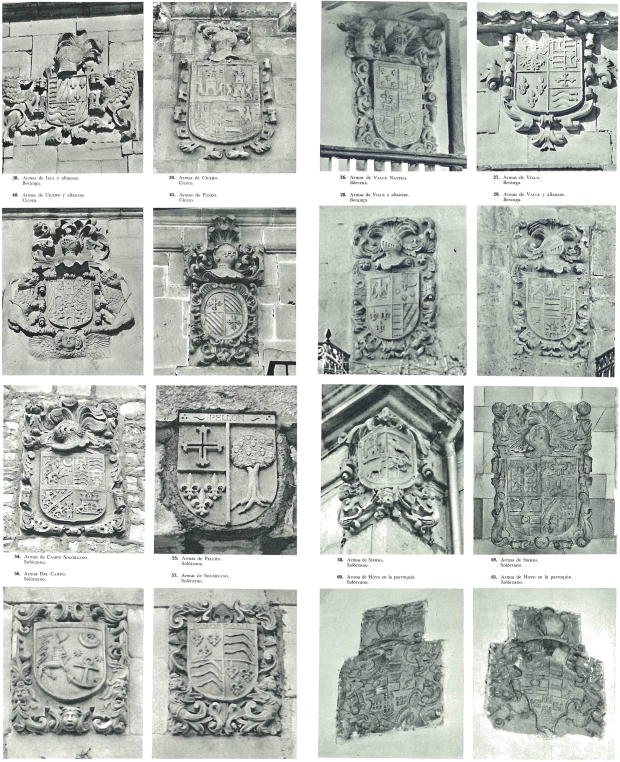
Maria del Carmen González Echegaray, «Escudos de Cantabria», 5 volumes, Volume I Merindad de Trasmiera, 376 pages, Volume II, Asturias de Santillana I, 474 pages, Volume III, Asturias de Santillana II, 388 pages, Volume IV, Asturias de Santillana y Bajo Asón, 434 pages, y Volume V, Valle de Sobra, Ruesga, Pas, Liendo, Guriezo y Provincia de Liébana, 314 pages, Legal deposit: Vi. 514-1969, edited by Joaquin Bedia Cano, Santander, printed by H. Fournier, Vitoria, 1969.
Bibliographical reference of century XX.
Classification: Castilian language and In black and white.
The author is González Echegaray, Maria del Carmen..
External links:
- Centro de Estudios Montañeses, Volume I Merindad de Trasmiera.
- Centro de Estudios Montañeses, Volume II, Asturias de Santillana I.
- Centro de Estudios Montañeses, Volume III, Asturias de Santillana II.
- Centro de Estudios Montañeses, Volume IV, Asturias de Santillana y Bajo Ason.
- Centro de Estudios Montañeses, Volume V, Valle de Sobra, Ruesga, Pas, Liendo, Guriezo y Provincia de Liebana.
Internal resources: GonzalezEchegarayMC1969.11.EscudosCantabria, Volume I Merindad de Trasmiera, 34 Mbytes, GonzalezEchegarayMC1969.12.EscudosCantabria, Volume II, Asturias de Santillana I, 31 Mbytes, GonzalezEchegarayMC1969.13.EscudosCantabria, Volume III, Asturias de Santillana II, 26 Mbytes, GonzalezEchegarayMC1969.14.EscudosCantabria, Volume IV, Asturias de Santillana y Bajo Ason, 22 Mbytes and and GonzalezEchegarayMC1969.15.EscudosCantabria, Volume V, Valle de Sobra, Ruesga, Pas, Liendo, Guriezo y Provincia de Liebana, 18 Mbytes.


![Ver [Guimera López, C.; 1987] en referencias bibliográficas. Libro abierto, hojas de plata, filo de oro, guardas de gules, tapas de sable.](../css/Libro.Bibliografia.png)
Guimera López, C.; 1987
Coriolano Guimera López, «El Conde de Mora y la Heráldica», Hidalguía Magazine, numbers 202 and 203, Ediciones Hidalguía, Madrid, 1987.
Bibliographical reference of century XX.
The author is Guimera López, Coriolano.
External link:


![Ver [Herrera Casado, A.; 1993] en referencias bibliográficas. Libro abierto, hojas de plata, filo de oro, guardas de gules, tapas de sable.](../css/Libro.Bibliografia.png)
Herrera Casado, A.; 1993
Antonio Herrera Casado, «The Armorial of Aragon», Annals of the Royal Matritense Academy of Heraldry and Genealogy, pages 137-220, Madrid, 1992-1993.


![Ver [Humphery-Smith, C.; 1983] en referencias bibliográficas. Libro abierto, hojas de plata, filo de oro, guardas de gules, tapas de sable.](../css/Libro.Bibliografia.png)
Humphery-Smith, C.; 1983
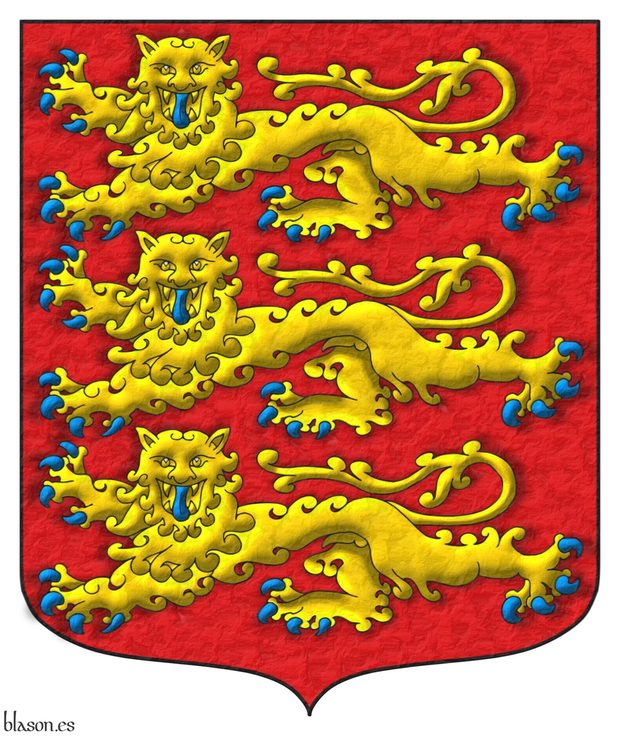
Cecil Humphery-Smith, FHS - Fellow of The Heraldry Society, «Why three Leopards?», Coat of Arms, COA, An Heraldic Quarterly Magazine, issue 126, The Heraldry Society, Baldock, Hertfordshire, summer of 1983.
The coat of arms illustrating this bibliographic reference is that of the Kingdom of England, which was also that of the queen of Castile Leonor Plantagenet.
Bibliographical reference of century XX.
The author is Humphery-Smith, Cecil.
The following articles cite this bibliographic reference:
External link:
Internal resources: HumpherySmithC1983.3Leopards.docx.


![Ver [Iguiniz, J. B.; 1920] en referencias bibliográficas. Libro abierto, hojas de plata, filo de oro, guardas de gules, tapas de sable.](../css/Libro.Bibliografia.png)
Iguiniz, J. B.; 1920
Juan B. Iguiniz, «The National Coat of Arms: A Documented and Illustrated Historical Monograph», Member of the Royal Academy of History, 37 pages, Bouret Widow's Bookstore, Rue Visconti 53, Paris 23, Avenida Cinco de Mayo 45, Mexico 45, printed by Franco-Mexican Printing Company, S.A., calle de la Academia 10, Mexico, 1920.
A work focusing on the national arms of Mexico.
Bibliographical reference of century XX.
Classification: Castilian language and In black and white.
Author: Iguiniz, Juan B..
Internal resources: IguinizJB1920.Mexico.pdf PDF format.

![Ver [Labandeira Fernández, A.; 1977] en referencias bibliográficas. Libro abierto, hojas de plata, filo de oro, guardas de gules, tapas de sable.](../css/Libro.Bibliografia.png)
Labandeira Fernández, A.; 1977
Amancio Labandeira Fernández, «The Passo Honroso of Suero de Quiñones. Introduction and edition by Amancio Labandeira Fernández», 438 pages, 24 plates, 8 genealogical trees, Fundación Universitaria Española, Collection Clásicos Olvidados of Espasa-Calpe, Madrid, 1977.
This edition, written by Clemente Bravo Guarida, provides an updated account of the famous «Passo Honroso», based on [Rodríguez de Lena, P.; Century XVI], undertaken by the renowned knight Suero de Quiñones and his 9 companions against 68 knights in 1434 at the bridge of Órbigo.
Bibliographical reference of century XX.
Classification: Castilian language.
The author is Labandeira Fernández, Amancio.


![Ver [Liñán y Eguizábal, J. de; 1911] en referencias bibliográficas. Libro abierto, hojas de plata, filo de oro, guardas de gules, tapas de sable.](../css/Libro.Bibliografia.png)
Liñán y Eguizábal, J. de; 1911
José de Liñán y Eguizábal, Count of Doña Marina, «Armorial of Aragon», printed by Establecimiento Tipográfico de L. Pérez, Huesca, 1911.
This book is part of a collection that also includes: «Heraldic Mottos» and «Heraldic Dictionary».
A facsimile edition exists, edited by Guillermo Redondo Veintemillas and Alberto Montaner Frutos, published by Institución Fernando el Católico, Zaragoza, 1994.
Bibliographical reference of century XX.
Classification: De bibliotheca, Armorial roll, Dictionary, In black and white and Castilian language.
Author: Liñán y Eguizábal, José de.
External resource:
Internal resources: LinanEguizabalJ1911.ArmorialDeAragon.Color.pdf PDF version scanned in color, although the book is in black and white, it looks more natural, LinanEguizabalJ1911.ArmorialDeAragon.BN.pdf PDF version scanned in black and white, it looks less natural and Facsimile edition in physical paper format.


![Ver [Martinena Ruiz, J. J.; 1982] en referencias bibliográficas. Libro abierto, hojas de plata, filo de oro, guardas de gules, tapas de sable.](../css/Libro.Bibliografia.png)
Martinena Ruiz, J. J.; 1982
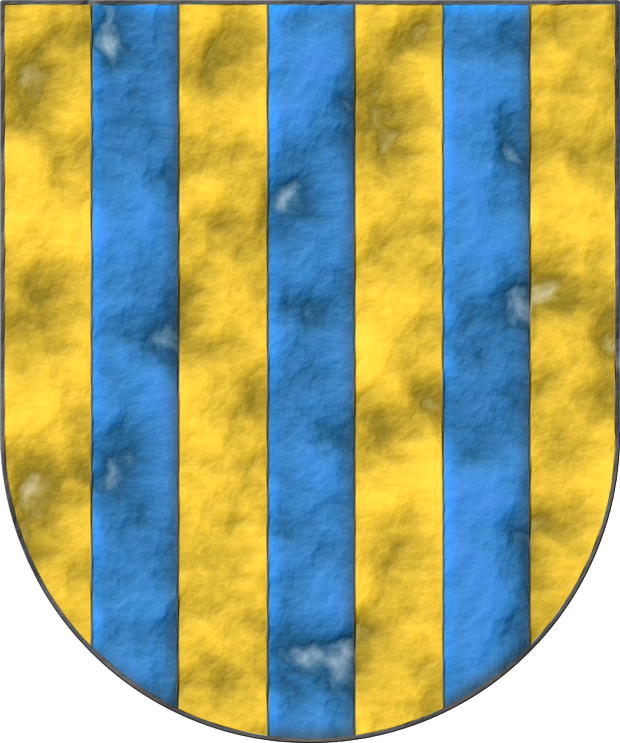
Juan José Martinena Ruiz, «Book of Armory of the Kingdom of Navarra: Introduction, Study, and Notes», published by the Institución Príncipe de Viana, 350 pages, ISBN 84-235-0557-X, Pamplona, 1982.
Introduction, study, and notes on the armorial [Bosque, J. del; 1540]. On pages 122 and 123, the coats of arms of the «ricoshombres» of Navarra, or «twelve barons of the major houses» as they are also called, surrounding the king's coat of arms in this armorial are compiled and transcribed.
The coat of arms accompanying this bibliographic reference is that of Almorrabides de Navarra following Juan del Bosque.
Bibliographical reference of century XX.
The author is Martinena Ruiz, Juan José.
The following articles cite this bibliographic reference:
- Almorrabides of Navarre
- Aybar of Navarre
- Baztanes of Navarre
- Bosque, J. del; 1540
- Guebara of Navarre
- Lete of Navarre
- Martinena Ruiz, J. J.; Menéndez Pidal de Navascués, F.; 2001
- Mauleón of Navarre
- Monteagudo of Navarra
- Navarra, closed carbuncle
- Noblemen of Navarre
- Qasqante of Navarre
- Rada of Navarre
- Subiça of Navarre
- Urroz of Navarre
- Vidaurre of Navarre
External links:


![Ver [Mayer, L. A.; 1933] en referencias bibliográficas. Libro abierto, hojas de plata, filo de oro, guardas de gules, tapas de sable.](../css/Libro.Bibliografia.png)
Mayer, L. A.; 1933
Leo Aryeh Mayer, «Saracenic Heraldry: A Survey», published by the University of Oxford at the Clarendon Press, Oxford, 1933.
The work provides a fully documented armorial roll of Saracenic sultans, princes, and knights, designed to meet the frequently expressed wish of students of Muslim archaeology. It is a fundamental reference work and remains as one of the most authoritative works on this subject.


![Ver [Menéndez Pidal de Navascués, F.; 1963] en referencias bibliográficas. Libro abierto, hojas de plata, filo de oro, guardas de gules, tapas de sable.](../css/Libro.Bibliografia.png)
Menéndez Pidal de Navascués, F.; 1963
Faustino Menéndez Pidal de Navascués, «A Leónese Heraldic Embroidery: the Carbuncle in Medieval Coats of Arms», published in the journal Armas e Troféus, 2nd series, Volume IV, pages 5-19, Braga, 1963.
Article reissued and included, 36 years later, in his book [Menéndez Pidal de Navascués, F.; 1999; pages 47-66].
Also published later in the Revista Príncipe de Viana, ISSN 0032-8472, year number 68, issue number 241, dedicated to the tribute to Faustino Menéndez Pidal de Navascués, pages 403-412, Government of Navarra, Institución Príncipe de Viana, Pamplona, 2007.
[Martínez de Aguirre, J.; 2007; page 344 and following] provides a good analysis of the importance of this work both for Navarrese heraldry and specifically for its coat of arms, as well as for heraldry in general.
Bibliographical reference of century XX.
Author: Menéndez Pidal de Navascués, Faustino.
Here are the articles quoting this reference:
- Martínez de Aguirre, J.; 2007
- Menéndez Pidal de Navascués, F.; 1999
- Navarra, closed carbuncle
- Navarre
- University of Navarra
External resource:
Internal resources: MenendezPidalDeNavascuesF1963.BordadoHeraldicoLeonesCarbuncloEscudosMedievales.pdf.


![Ver [Menéndez Pidal de Navascués, F.; 1974] en referencias bibliográficas. Libro abierto, hojas de plata, filo de oro, guardas de gules, tapas de sable.](../css/Libro.Bibliografia.png)
Menéndez Pidal de Navascués, F.; 1974
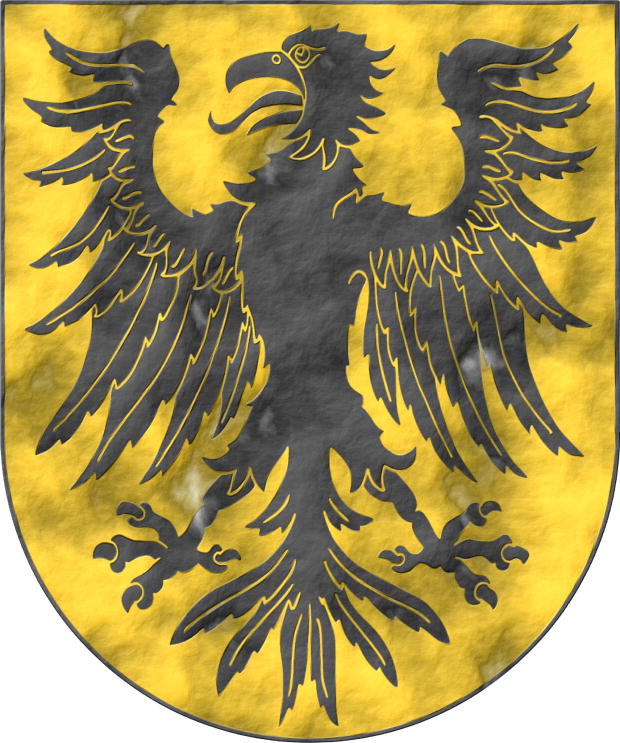
Faustino Menéndez Pidal de Navascués, «Book of Armory of the Kingdom of Navarra: Transcription and Study», published by La Gran Enciclopedia Vasca, 160 pages, ISBN 84-248-0119-9, Bilbao, 1974.
Transcription and study of the Navarrese manuscript armorial [Bosque, J. del; 1540], preserved in the General Archive of Navarra.
This book contains an introduction, the transcription of the armorial texts, its photographic reproduction, which also includes the Navarrese coats of arms of the Reyneck armorial and the coat of arms of the refectory of the Cathedral of Santa María la Real de Pamplona, an index of names, a heraldic table, and a set of appendices [Martínez de Aguirre, J.; 2007; page 351].
The coat of arms accompanying this bibliographic reference is that of Qasqante de Navarra following, precisely, the armorial of Juan del Bosque.
Bibliographical reference of century XX.
Author: Menéndez Pidal de Navascués, Faustino.
Bibliographic reference mentioned in the following articles:
- Bosque, J. del; 1540
- Martinena Ruiz, J. J.; Menéndez Pidal de Navascués, F.; 2001
- Navarra, closed carbuncle
External resources:


![Ver [Menéndez Pidal de Navascués, F.; 1982] en referencias bibliográficas. Libro abierto, hojas de plata, filo de oro, guardas de gules, tapas de sable.](../css/Libro.Bibliografia.png)
Menéndez Pidal de Navascués, F.; 1982
Faustino Menéndez Pidal de Navascués, «Medieval Spanish Heraldry I: The Royal House of Leon and Castile», illustrations by Jaime Bugallal y Vela, edited by the Salazar and Castro Institute, (C. S. I. C. Higher Center for Scientific Research), published by Hidalguía, 271 pages, size 24 x 17 cm, includes color plates, Legal deposit M. 22.165-1982, ISBN 84-00-05150-5, printed by Imprenta Sáez, Madrid, 1982.
Index
- Introduction, page 11.
- Abbreviations, page 22.
- Alfonso VII, page 23.
- Fernando II, page 39.
- Alfonso VIII, page 47.
- The spread of the arms of Castile, schema between pages 48 and 47.
- Alfonso IX, page 71.
- Fernando III, page 87.
- Alfonso X, page 109.
- Origins of differentiated arms, schema between pages 48 and 47.
- Sancho IV, page 129.
- Fernando IV, page 139.
- Alfonso XI, page 141.
- Pedro I, page 157.
- Henry II, page 165.
- John I, page 177.
- Henry III, page 185.
- John II, page 189.
- Henry IV, page 195.
- Isabella and Ferdinand, page 199.
- Children of the Catholic Monarchs, page 207.
- Evolution of the arms of Spain, page 213.
- The House of Austria, page 239.
- The Houses of Two Sicilies and Parma, page 241.
- Arms of Castile and Leon outside the Royal House, page 243.
- Index nominum, page 265.
- Index rerum, page 271.
Bibliographical reference of century XX.
Classification: Black and white with color plates and Castilian language.
Author: Menéndez Pidal de Navascués, Faustino.
The following article cites this bibliographic reference:
Internal resources: Physical book in paper.


![Ver [Menéndez Pidal de Navascués, F.; 1985] en referencias bibliográficas. Libro abierto, hojas de plata, filo de oro, guardas de gules, tapas de sable.](../css/Libro.Bibliografia.png)
Menéndez Pidal de Navascués, F.; 1985
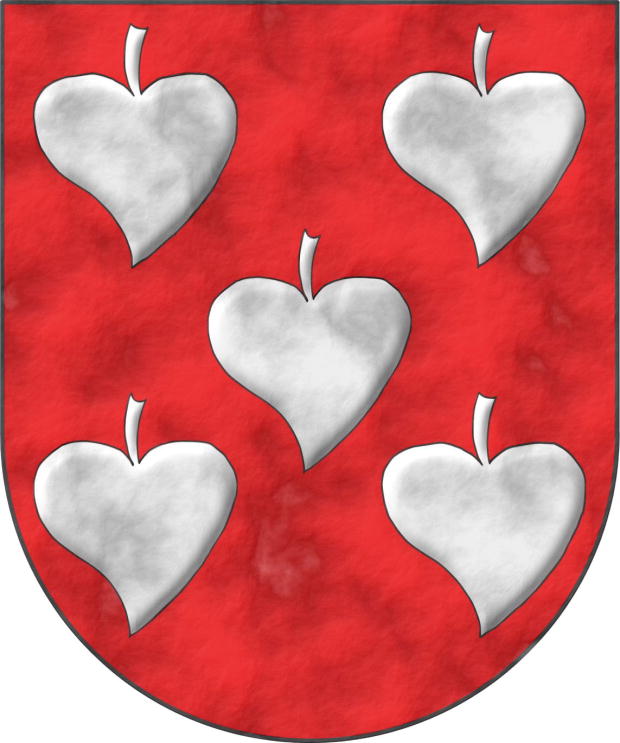
Faustino Menéndez Pidal de Navascués, «Rare and Ambiguous Charges of Spanish Heraldry», Revista Hidalguía, issue 190 and 191, Ediciones Hidalguía, Madrid, 1985.
The coat of arms with squares accompanying this bibliographic reference is that of Guebara de Navarra, an interpretation based on that by [Bosque, J. del; 1540]. I chose this coat of arms because Faustino Menéndez Pidal writes precisely about it and about the squares as a figure typical of Spanish heraldry, for example, he does so on pages 474 and 475 of this article.
Bibliographical reference of century XX.
The author is Menéndez Pidal de Navascués, Faustino.
The following article cites this bibliographic reference:
External link:
Internal resources: MenendezPidalDeNavascuesF1985.MueblesRarosHeraldicaEspañola.pdf.


![Ver [Menéndez Pidal de Navascués, F.; 1988] en referencias bibliográficas. Libro abierto, hojas de plata, filo de oro, guardas de gules, tapas de sable.](../css/Libro.Bibliografia.png)
Menéndez Pidal de Navascués, F.; 1988
Faustino Menéndez Pidal de Navascués, «Spanish Heraldic Panorama: Epochs and Regions in the Medieval Period», paper presented at the I Seminar on Heraldry and Genealogy, organized by the Zurita Chair of the Institución Fernando el Católico, in Zaragoza, on December 14 and 15, 1984, published in I Seminar on Heraldry and Genealogy, publication number 1.138 of the Institución Fernando el Católico, pages 5-21, Zaragoza, 1988.
Also published later in the Revista Príncipe de Viana, ISSN 0032-8472, year number 68, issue number 241, dedicated to the tribute to Faustino Menéndez Pidal de Navascués, pages 533-553, Government of Navarra, Institución Príncipe de Viana, Pamplona, 2007.
Bibliographical reference of century XX.
Author: Menéndez Pidal de Navascués, Faustino.
Here are the articles quoting this reference:
External resource:
Internal resources: MenendezPidalDeNavascuesF1988.PanoramaHeraldicoEspanolEpocasYRegionesEnElPeriodoMedieval.pdf.


![Ver [Menéndez Pidal de Navascués, F.; 1999] en referencias bibliográficas. Libro abierto, hojas de plata, filo de oro, guardas de gules, tapas de sable.](../css/Libro.Bibliografia.png)
Menéndez Pidal de Navascués, F.; 1999
Faustino Menéndez Pidal de Navascués, «Lions and Castles: Heraldic Emblems in Spain», published by the Real Academia de la Historia, ISBN 9788489512399, 306 pages, Madrid, 1999.
This book also includes his article [Menéndez Pidal de Navascués, F.; 1963] which, based on the observation of a «Leonese embroidery» concludes about the carbuncle and the coat of arms of Navarra.
Bibliographical reference of century XX.
The author is Menéndez Pidal de Navascués, Faustino.
Here are the articles quoting this reference:


![Ver [Menéndez Pidal de Navascués, F.; Martínez de Aguirre, J.; 2000] en referencias bibliográficas. Libro abierto, hojas de plata, filo de oro, guardas de gules, tapas de sable.](../css/Libro.Bibliografia.png)
Menéndez Pidal de Navascués, F.; Martínez de Aguirre, J.; 2000
Faustino Menéndez Pidal de Navascués and Javier Martínez de Aguirre Aldaz, «The Coat of Arms of Navarra», published by the Government of Navarra, Department of Presidency, Justice, and Interior, ISBN 84-235-2016-1, 115 pages, Pamplona, 2000.
This is one of the many publications by Faustino Menéndez Pidal de Navascués on the Navarrese armorial [Bosque, J. del; 1540]. Later, 7 years after, Javier Martínez de Aguirre Aldaz, co-author of this book, would publish an interesting article, [Martínez de Aguirre, J.; 2007], about Faustino Menéndez Pidal de Navascués as a researcher of Navarrese heraldry.
Bibliographical reference of century XX.
Authors: Menéndez Pidal de Navascués, Faustino and Martínez de Aguirre Aldaz, Javier.
The following articles cite this bibliographic reference:
External link:


![Ver [Messía de la Cerda y Pita, L.; 1990] en referencias bibliográficas. Libro abierto, hojas de plata, filo de oro, guardas de gules, tapas de sable.](../css/Libro.Bibliografia.png)
Messía de la Cerda y Pita, L.; 1990
Luis Messía de la Cerda y Pita, «Heráldica española, el diseño heráldico», illustrated in color by Calusa y Tete Messia de la Cerda y Gabeiras, edited by Aldaba Ediciones SA Madrid, 1990.
Bibliographical reference of century XX.
Classification: Castilian language and Black and white and color illustrations.
Author: Messía de la Cerda y Pita, Luis.
Here are the articles quoting this reference:
- Baztanes of Navarre
- Philip of Castile, Infante
- Pile issuant from the base in the Dictionary of the Spanish Language
Internal resources: Paper book.


![Ver [Mogrobejo Zabala, E. de; 1991] en referencias bibliográficas. Libro abierto, hojas de plata, filo de oro, guardas de gules, tapas de sable.](../css/Libro.Bibliografia.png)
Mogrobejo Zabala, E. de; 1991
Endika de Mogrobejo Zabala, «Blasones y Linajes de Euskalerria», 10 volumes, Volume I A-Alcerreca, Volume II Alciba-Angui, Volume III Angulo-Astu, Volume IV Astun-Bun, Volume V Busta-Elua, Volume VI Elus-Gorniz, Volume VII Gordu-Laca, Volume VIII Lacar-Merca, Volume IX Mere-Salez, Volume X Salinas-Z, edited by Editorial Amigos del Libro Vasco, printed by Grafo SA, ISBN of the complete work 84-7886-026-6, legal Deposit BI-469-1991, Bilbao, 1991.
Bibliographical reference of century XX.
Classification: De bibliotheca, Black and white with color plates and Castilian language.
The author is Mogrobejo Zabala, Endika de.


![Ver [Moncreiffe, I.; Pottinger, D.; 1953] en referencias bibliográficas. Libro abierto, hojas de plata, filo de oro, guardas de gules, tapas de sable.](../css/Libro.Bibliografia.png)
Moncreiffe, I.; Pottinger, D.; 1953
Iain Moncreiffe of Easter Moncreiffe, Advocate, Kintyre Pursuivant of Arms, Don Pottinger, Herald Painter Extraordinary to the Court of the Lord Lyon King of Arms, «Simple Heraldry», first edition, edited by Thomas Nelson and Sons, 63 pages, color illustrations, 25 centimeters, hardcover, Edinburgh, 1953.
My edition has been published 1993 by The Promotional Reprint Company Limited exclusively for Bookman Ltd, Desford Road, Enderby, Leicester, LE9 5AD, Coles in Canada, Barnes & Noble in America, and Treasure Press in Australia, ISBN 1 85648 115 8, Printed and bound in Hong Kong.
Bibliographical reference of century XX.
Classification: De bibliotheca, In color and English language.
The 2 authors are Moncreiffe, Iain and Pottinger, Don.
Internal resources: Physical book on paper.


![Ver [Neubecker, O.; 1976] en referencias bibliográficas. Libro abierto, hojas de plata, filo de oro, guardas de gules, tapas de sable.](../css/Libro.Bibliografia.png)
Neubecker, O.; 1976
Ottfried Neubecker, Member, Governing Board International Academy Of Heraldry «Heraldry: Sources, Symbols and Meaning», with contributions by J. P. Brooke-Little, Richmond Herald Of Arms, designed by Robert Tobler, first published in Great Britain in 1977 original graphic concept by Emil Buhrer, edition by Floyd Yearout, managing Editor Francine Peeters, editor of the original in German Corinna Reich, illustrations by Franz Coray and Werner Luzi, picture acquisition by Edith Burgler, production manager Franz Gisler, translator of German text Nicholas Fry, copy editor and proofreader Daryl Sharp, composition by Hertig & Co. AG, Biel, Switzerland, photolithography by Kreienbuhl AG, Lucerne and Actual, Biel, Switzerland, printed by Polygraphische Gesellschaft, Laupen, Switzerland, bound by Webb Son and Company Limited, copyright 1976 by McGraw-Hill Book Co, UK Limited, Maidenhead, England, a McGraw-Hill Co-Publication, 294 pages, ISBN 0 354 04157 6, by Macdonald and Jane's Publishers, 8 Shepherdess Walk, London, 1976.
Bibliographical reference of century XX.
Classification: De bibliotheca, In color and English language.
The author is Neubecker, Ottfried.
Internal resources: Physical book on paper.


![Ver [Nieto y Cortadellas, R.; 1957a] en referencias bibliográficas. Libro abierto, hojas de plata, filo de oro, guardas de gules, tapas de sable.](../css/Libro.Bibliografia.png)
Nieto y Cortadellas, R.; 1957a
Rafael Nieto y Cortadellas, «La Generala Santander y sus parientes habaneros los Pontón», 35 pages, 25 centimeters, about the family Sáenz del Pontón, National Archive of Cuba, reprinted edition by the National Archive Bulletin, volume LVI, 1957.
Bibliographical reference of century XX.
Classification: Castilian language.
The author is Nieto y Cortadellas, Rafael.
Bibliographical reference mentioned in the following article:
External links:


![Ver [Parker, J.; 1970] en referencias bibliográficas. Libro abierto, hojas de plata, filo de oro, guardas de gules, tapas de sable.](../css/Libro.Bibliografia.png)
Parker, J.; 1970
James Parker, «A Glossary of Terms Used in Heraldry, a New Edition with one Thousand Illustrations», XXVIII and 660 pages with pictures, reprinted by F and W Media International Limited, formerly known as David and Charles Publishers, Exeter, Devon, 1970.
Bibliographical reference of century XX.
Classification: Dictionary and English language.
The author is Parker, James.
Here are the articles quoting this reference:


![Ver [Parker, J.; 1971] en referencias bibliográficas. Libro abierto, hojas de plata, filo de oro, guardas de gules, tapas de sable.](../css/Libro.Bibliografia.png)
Parker, J.; 1971
James Parker, «A Glossary of Terms Used in Heraldry, a New Edition with one Thousand Illustrations», XXVIII and 660 pages with pictures, reprinted by Charles E. Tuttle Co., Rutland, Vermont, 1971.
Bibliographical reference of century XX.
Classification: Dictionary and English language.
The author is Parker, James.
Here are the articles quoting this reference:


![Ver [Parker, J.; Gough, H.; 1966] en referencias bibliográficas. Libro abierto, hojas de plata, filo de oro, guardas de gules, tapas de sable.](../css/Libro.Bibliografia.png)
Parker, J.; Gough, H.; 1966
James Parker, Henry Gough, «A Glossary of Terms Used in Heraldry, a New Edition with one Thousand Illustrations», XXVIII and 660 pages with pictures, reprinted by Gale Research Company, Detroit, 1966.
Reprints
This book is a reprint of [Parker, J.; 1894], it maintains the number of pages, I do not know what Henry Gough contributed as an author, in some places Henry Gough is the first author, in others he is named as the sole author, I write his name as 2nd author.
There are, at least, 2 addional paper reprints: [Parker, J.; 1970; David and Charles Publishers] and [Parker, J.; 1971; Charles E. Tuttle Co], and many digital versions.
Bibliographical reference of century XX.
Classification: Dictionary and English language.
The 2 authors are Parker, James and Gough, Henry.
The following articles cite this bibliographic reference:


![Ver [Parsons, R. J.; 1989] en referencias bibliográficas. Libro abierto, hojas de plata, filo de oro, guardas de gules, tapas de sable.](../css/Libro.Bibliografia.png)
Parsons, R. J.; 1989
Robert John Parsons, heraldic painter at the College of Arms, «The Herald Painter», is an article derived from the lecture given by R. J. Parsons at The Heraldry Society on January 18, 1989, at the premises of «The Society of Antiquaries» at Burlington House, London, and later published in Coat of Arms, COA, An Heraldic Quarterly Magazine, issue 146, The Heraldry Society, Baldock, Hertfordshire, summer of 1989.
This article presents a historical review of the heraldic painters at the «College of Arms» and analyzes the creation of coats of arms and other objects like badges, flags, stained glass, seals, etc. It is especially interesting for its view of the current stage of heraldic art and, even more, the description of the author's own working method.
I highly recommend reading this article and, here, I present some of the ideas that I highlighted while studying this text by R. J. Parsons, who is «herald painter to Her Majesty's College of Arms».
Tradition and innovation in heraldic art
Creativity, innovation, and achieving a unique style are fundamental characteristics of any self-respecting artist, but when artists enter the realm of heraldry and, especially when working for institutions like the College of Arms, the weight of the norms and rules of heraldry, its long historical tradition, the reverential respect towards it, the language of blazon, the need for a long initiation process, etc. can cause artists to curb their natural impulses, become intimidated, and adhere strictly to rules to avoid criticism, which hinders the introduction of new proposals, ideas, and styles, risking making heraldry a static and time-bound field.
R. J. Parsons' working method
Robert Parsons explains that the first phase of his method is to create the complete drawing of the coat of arms and its ornamentation on tracing paper, starting with the coat of arms and then outlining all the external ornamentation.
He does this considering that the main problem he must solve is reconciling the two-dimensionality of the coat of arms with the three-dimensionality of the external ornamental elements, such as the supporters, mantling, crest, etc. which must be designed as if enveloping the coat of arms. The extent to which this is achieved provides an idea of each artist's skill.
Silhouettes, expressiveness, and balance
R. J. Parsons believes that the silhouettes of the figures probably characterize each artist and their designs the most. For him, each silhouette must be bold and express emotions, and the silhouettes must maintain proportions that give balance to the whole, as there are no rules that guarantee a good aesthetic result.
To achieve boldness and expressiveness in the figures, especially in natural ones, the artist must emphasize certain features and stylize others, resulting in, for example, in beasts and birds, representations that diverge from natural reality.
Shape of the coat of arms and space
All delineation must be done within the chosen mouth shape for the coat of arms. These shapes have evolved over time, and the artist must consider that some shapes facilitate the internal composition of the coat of arms more than others. For example, he highlights the difficulty of fitting the pieces and figures within lozenge-shaped shields, traditionally carried by unmarried women.
Regardless of the chosen shape, pieces and figures must be arranged to use the entire internal space correctly, neither too small to leave space nor too large to make the whole crowded.
External ornamentation
Robert J. Parsons observes that nowadays the protocol rules that used to govern external ornamentation have been greatly relaxed, for example, regarding the shapes, positions, and orientations of the helmets depending on who would be the holder of the coat of arms, and this relaxation has favored art, aesthetics, and the balance of the whole coat of arms.
He states that of all the external ornamentation, and many heraldic artists will agree with him, the most complex to create are the supporters and tenants, and of the three, the tenants, i.e., human figures, are the most difficult.
Human figures do not have a proper heraldic characterization as lions, unicorns, boars, etc., do. The characterization of women and men in heraldry is done through their attire and the objects they carry or accompany them, with ancient attire and objects being the easiest to characterize, while the more modern and, even more so, the more naked they are, the more difficult and challenging it becomes to create heraldically attractive tenants.
As a general rule, Parsons advises that the visual weight of supporters, tenants, and tenants be similar to that of the coat of arms, so that they neither draw all the observer's attention due to their excessive size nor look ridiculous and incapable of performing their function, which is to support the visual weight of the coat of arms.
Tinctures, shadows, edges, and highlights
When he finishes the drawing phase, R. J. Parsons explains how he transfers it to a new paper support and, then:
- he starts by applying the tinctures for the metals,
- the first he applies is gold using gold powder, although it is known that other artists use gold leaf,
- then the metal silver is left as the white of the paper,
- then he proceeds with the colors, using gouache, an opaque watercolor, following the order from light to dark,
- so the first color he applies is gules, which he tends to make somewhat translucent,
- then the mid-tones, azure and vert.
- ending with sable, which he makes warmer with a touch of burnt sienna,
- after applying the tinctures, he adds shadows to suggest forms, noting that some schools say everything should be in flat inks, without shadows or highlights, and even without delineated edges as can be seen, for example, in Norsk Heraldisk Forening,
- then he delineates the silhouettes and
- finishes by adding highlights to bring the composition to life.
The motto or slogan is the last element with which Robert John Parsons completes the creation of a coat of arms.
Bibliographical reference of century XX.
The author is Parsons, Robert John.
External link:
Internal resources: ParsonsRJ1989.TheHeraldPainter.docx.


![Ver [Pastoureau, M.; Garvie, F.; 1997] en referencias bibliográficas. Libro abierto, hojas de plata, filo de oro, guardas de gules, tapas de sable.](../css/Libro.Bibliografia.png)
Pastoureau, M.; Garvie, F.; 1997
Michel Pastoureau and Francisca Garvie, «Heraldry: Its Origins and Meaning», New Horizons collection, edited by Thames and Hudson, London, 1997.
Bibliographical reference of century XX.
The 2 authors are Pastoureau, Michel and Garvie, Francisca.
Bibliographical reference mentioned in the following article:


![Ver [Rabbow, A.; 1999] en referencias bibliográficas. Libro abierto, hojas de plata, filo de oro, guardas de gules, tapas de sable.](../css/Libro.Bibliografia.png)
Rabbow, A.; 1999
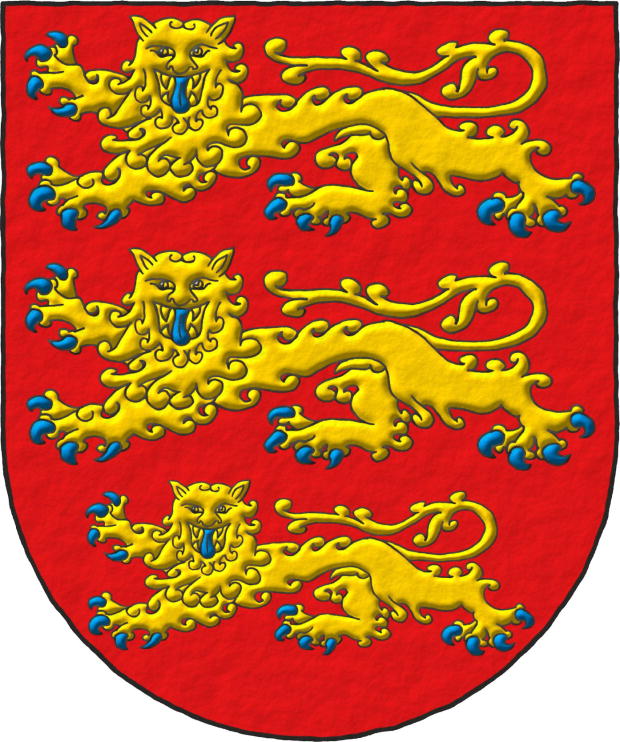
Arnold Rabbow, «The Origin of the Royal Arms of England - a European Connection», Coat of Arms, COA, An Heraldic Quarterly Magazine, número 186, The Heraldry Society, Baldock, Hertfordshire, verano de 1999.
This bibliographical reference is illustrated wit the coat of arms of the Kingdom of England interpreted by me with the with a semi-circle shape.
Bibliographical reference of century XX.
Author: Rabbow, Arnold.
The following article cites this bibliographic reference:
External resource:
Internal resources: RabbowA1999.OriginRoyalArmsEnglandEuropeanConnection.docx.


![Ver [Rowling, J. K.; 1997] en referencias bibliográficas. Libro abierto, hojas de plata, filo de oro, guardas de gules, tapas de sable.](../css/Libro.Bibliografia.png)
Rowling, J. K.; 1997
J. K. Rowling, «Harry Potter and the Philosopher’s Stone», London Bloomsbury, London, 1997.
Bibliographical reference of century XX.
Author: Rowling, Joanne.
Here are the articles quoting this reference:


![Ver [Royal Spanish Academy; 1992] en referencias bibliográficas. Libro abierto, hojas de plata, filo de oro, guardas de gules, tapas de sable.](../css/Libro.Bibliografia.png)
Royal Spanish Academy; 1992
Real Academia Española, «Diccionario de la lengua española», known as DRAE, acronym for Diccionario de la Real Academia Española, 83,000 entries, 21st edition, Espasa Calpe, Madrid, 1992.
Bibliographical reference of century XX.
Classification: Dictionary and Castilian language.
Author: Royal Spanish Academy.
External resource:


![Ver [Sánchez Albornoz, C.; 1965] en referencias bibliográficas. Libro abierto, hojas de plata, filo de oro, guardas de gules, tapas de sable.](../css/Libro.Bibliografia.png)
Sánchez Albornoz, C.; 1965
Claudio Sánchez Albornoz, «La auténtica batalla de Clavijo», Cuadernos de Historia de España, number 9, Buenos Aires, 1948.
Bibliographical reference of century XX.
The author is Sánchez Albornoz, C..
Bibliographical reference mentioned in the following article:
External resource:


![Ver [Sarandeses Pérez, F.; 1966] en referencias bibliográficas. Libro abierto, hojas de plata, filo de oro, guardas de gules, tapas de sable.](../css/Libro.Bibliografia.png)
Sarandeses Pérez, F.; 1966
Francisco Sarandeses Pérez, of the Institute of Asturian Studies and of the International Institute of Genealogy and Heraldry, «Heraldry of Asturian Surnames», 408 pages, black and white illustrations, 27 centimeters, includes bibliography and indexes, foreword by H.R.H. The Duke of Calabria, prologue by The Hon. Mr. Julio de Atienza, Baron of Cobos de Belchite, photographs by Mr. Jesús González-Galatea, published by the Asturian Studies Institute of the José María Quadrado Trust, Superior Center for Scientific Research, Provincial Council of Oviedo, printed by Gráficas Europa. Legal Deposit S. 137-1966, Oviedo, 1966.
Cover of the original 1966 edition reproduced in the second facsimile edition of 1994.
Bibliographical reference of century XX.
Classification: Castilian language and In black and white.
Author: Sarandeses Pérez, Francisco.
Bibliographical reference mentioned in the following article:

![Ver [Sarandeses Pérez, F.; 1994] en referencias bibliográficas. Libro abierto, hojas de plata, filo de oro, guardas de gules, tapas de sable.](../css/Libro.Bibliografia.png)
Sarandeses Pérez, F.; 1994
Francisco Sarandeses Pérez, of the Institute of Asturian Studies and of the International Institute of Genealogy and Heraldry, «Heraldry of Asturian Surnames», 408 pages, 89 color plates, black and white illustrations, 27 centimeters, includes bibliography and indexes. prologue to the facsimile edition by Dolores Duque de Estrada Castañeda and Fernando Alós Merry del Val, facsimile edition published by the Royal Institute of Asturian Studies of the José María Quadrado Trust, Superior Center for Scientific Research, printed by Eujoa Artes Gráficas, ISBN 84-87212-26-3, Legal Deposit AS.-1.309/94, Oviedo, 1994.
Reference to the original edition of 1966
The facsimile edition faithfully reproduces the original 1966, [Sarandeses Pérez, F.; 1966], published by the Provincial Council of Oviedo, with a foreword by H.R.H. The Duke of Calabria, prologue by The Hon. Mr. Julio de Atienza, Baron of Cobos de Belchite, and photographs by Mr. Jesús González-Galatea.
Bibliographical reference of century XX.
Classification: De bibliotheca, Castilian language and Black and white with color plates.
The author is Sarandeses Pérez, Francisco.
Internal resources: A facsimile edition as a physical book on paper.


![Ver [Scott-Giles, C. W.; 1965] en referencias bibliográficas. Libro abierto, hojas de plata, filo de oro, guardas de gules, tapas de sable.](../css/Libro.Bibliografia.png)
Scott-Giles, C. W.; 1965
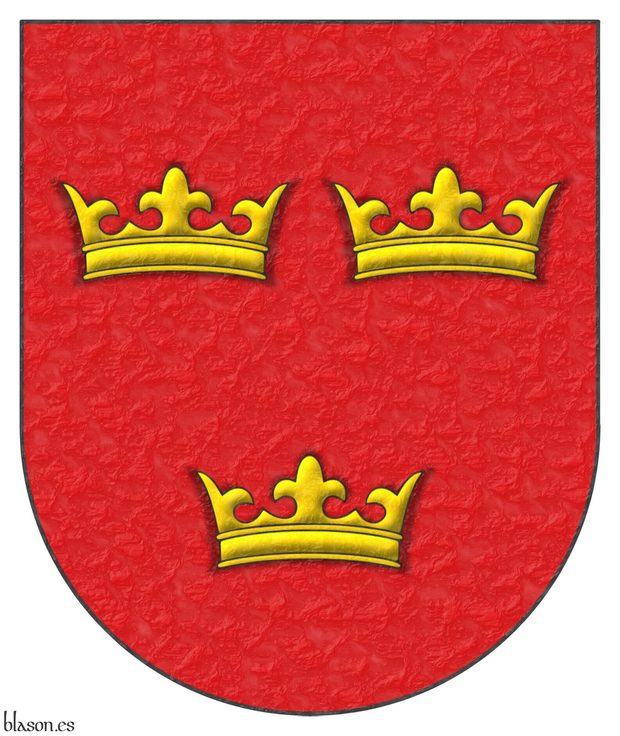
Charles Wilfred Scott-Giles, OBE (Officer of the Most Excellent Order of the British Empire), Fitzalan Pursuivant Extraordinary, «Some Arthurian Coats of Arms», Coat of Arms, COA, An Heraldic Quarterly Magazine, issue 64 of October 1965 (which is the date I use as reference) and issue 65 of January 1966, The Heraldry Society, Baldock, Hertfordshire, October 1965.
The coat of arms illustrating this bibliographic reference is one of the variants described in this article attributed to King Arthur, which in Blason.es is cataloged as Arthur of Britain.
Bibliographical reference of century XX.
The author is Scott-Giles, C. W..
Bibliographic reference mentioned in the following articles:
External resource:
Internal resources: ScottGilesCW1965.SomeArthurianCoA.docx.


![Ver [Sevilla Gómez, A.; 2000] en referencias bibliográficas. Libro abierto, hojas de plata, filo de oro, guardas de gules, tapas de sable.](../css/Libro.Bibliografia.png)
Sevilla Gómez, A.; 2000
Antonio Sevilla Gómez, «Las paremias heroicas: la divisa, el lema y el mote», Paremia Magazine, number 9, pages 75 to 80, Madrid, 2000.
Bibliographical reference of century XX.
The author is Sevilla Gómez, Antonio.
Bibliographical reference mentioned in the following article:
External link:
Internal resources: SevillaGomezA2000.DivisaLemaMoteGritoGuerra.pdf.


![Ver [Toral y Fernández de Peñaranda, E.; 1970] en referencias bibliográficas. Libro abierto, hojas de plata, filo de oro, guardas de gules, tapas de sable.](../css/Libro.Bibliografia.png)
Toral y Fernández de Peñaranda, E.; 1970
Enrique de Toral y Fernández de Peñaranda, «The Coat of Arms of the City of Úbeda: Notes for a Historical Study», Boletín del Instituto de Estudios Giennenses, pages 33-38 plus 10 illustrations, total 22 pages, number 66, ISSN 0561-3590, Jaen, 1970.
Bibliographical reference of century XX.
Classification: Article, Castilian language and In black and white.
The author is Toral y Fernández de Peñaranda, Enrique.
Internal resources: Provincial Council of Jaén https://www.dipujaen.es/boletinieg/pdf.raw?query=id:0000443974&page=38&lang=es&view=bieg and Rioja University https://dialnet.unirioja.es/descarga/articulo/2070193.pdf.


![Ver [Uhagón y Guardamino, F. R.; 1904] en referencias bibliográficas. Libro abierto, hojas de plata, filo de oro, guardas de gules, tapas de sable.](../css/Libro.Bibliografia.png)
Uhagón y Guardamino, F. R.; 1904
Francisco Rafael Uhagón y Guardamino, I Marqués de Laurencín, Director de la Real Academia de la Historia, Caballero de la Orden de Calatrava, «Libro de la Cofradía de Caballeros de Santiago de la Fuente, Fundada por los Burgaleses en Tiempo de Don Alfonso XI» noticia bibliográfica, publicada en la Revista de Archivos, Bibliotecas y Museos, impresa por la Tipográfica de la Revista de Archivos, Bibliotecas y Museos, calle de Olid 8, Madrid, 1904.
This article provides a bibliographical account of the illuminated manuscript [Cofradía de Santiago; Century XIV].
Bibliographical reference of century XX.
Classification: Article, Castilian language and In black and white.
The author is Uhagón y Guardamino, Francisco Rafael.
External resource:


![Ver [Vicente Cascante, I.; 1956] en referencias bibliográficas. Libro abierto, hojas de plata, filo de oro, guardas de gules, tapas de sable.](../css/Libro.Bibliografia.png)
Vicente Cascante, I.; 1956
Vicente Cascante, Ignacio, «General Heraldry and Sources of the Arms of Spain», published by Salvat, 22 x 28 centimeters, spine in leather, gilt-stamped, illustrated with 345 engravings in black and color, 648 pages, Barcelona, 1956.
Bibliographical reference of century XX.
Author: Vicente Cascante, Ignacio.


![Ver [Zamora Vicente, A.; 1999] en referencias bibliográficas. Libro abierto, hojas de plata, filo de oro, guardas de gules, tapas de sable.](../css/Libro.Bibliografia.png)
Zamora Vicente, A.; 1999
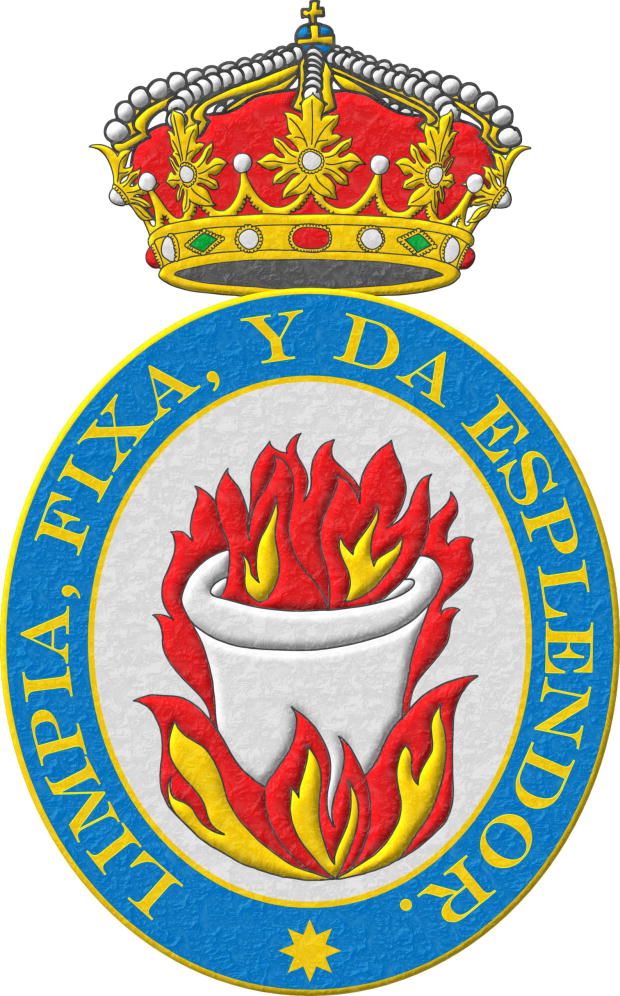
Alonso Zamora Vicente, «Historia de la Real Academia Española», Real Academia Española, Espasa Calpe, Madrid, 1999.
This bibliographic reference is illustrated with one of my interpretations of the emblem of the Real Academia Española. It is an oval emblem in Argent, with its crucible, also in Argent, over a bonfire of Gules and Or and surrounded by its flames, surmounted by a closed Royal crown with 8 arches, 5 of which are visible, and its motto, as originally written «Limpia, fixa, y da esplendor», around it.
Bibliographical reference of century XX.
Classification: Castilian language.
The author is Zamora Vicente, Alonso.
Bibliographical reference mentioned in the following article:
External resource:
-
Language
-
Categories of heraldry
-
Divisions of the field
- Without divisions
- Party per pale
- Party per fess
- Party per bend
- Party per bend sinister
- Tierce
- Tierce sinister
- Tierced per pale
- Tierced per fess
- Tierced per bend
- Tierced pallwise inverted
- Quarterly
- Quarterly per saltire
- Gyronny
- Party per fess, the chief per pale
- Party per pale, the sinister per fess
- Party per fess, the base per pale
- Party per pale, the dexter per fess
- Chapé
- Chaussé
- Embrassé
- Contre-embrassé
- Party per chevron
- Enté
- Enté en point
- Flanched
-
Metals
-
Colours
-
Furs
-
Other tinctures
-
Ordinaries and sub-ordinaries
-
Diminutives of the ordinaries
-
Geometric charges
-
Composite ordinaries
-
Inanimate charges from Nature
Atom, Crescent, Diamond, Emerald, Estoile, Increscent, Lightning flash, Moon, Mount, Mullet, Mullet of four points, Orbital, Plough of Ursa Major, Rainbow, Ray of the sun, River, Sea, Snowflake, Sun, Sun in splendour, Sun of May, Trimount and Water.
-
Vegetal charges from Nature
Acorn, Apple, Apple tree, Ash, Bluebonnet, Camellia, Chrysanthemum, Cinquefoil, Cornflower, Dogwood flower, Double rose, Elm, Fleur de lis, Flower, Gourd, Holm oak, Hop cone, Kapok tree, Laurel, Lily, Linden, Lotus flower, Madonna lily, Oak, Olive tree, Palm tree, Pomegranate, Poplar leaf, Rose, Shamrock, Sunflower, Thistle, Tree, Tulip, Vine and Wheat.
-
Animal charges from Nature
Badger, Bald eagle, Barbel, Barn owl, Bear, Beaver, Beetle, Bighorn sheep, Blackbird, Boar, Brach hound, Bull, Doe, Dog, Dolphin, Dove, Eagle, Elephant, Falcon, Fish, Flame, Fly, Fox, Frog, Goat, Goldfinch, Goose, Heron, Horse, Hummingbird, Jaguar, Lark, Leopard, Lion, Lion passant, Lion rampant guardant, Lioness, Lynx, Male figure, Martlet, Merino ram, Owl, Panther, Parrot, Peacock, Pelican, Pelican in her piety, Puffin, Quetzal, Raven, Roe deer, Rooster, Savage, Seagull, Serpent, She-wolf, Stag, Starling, Talbot, Tyger, Vulture, Warren hound and Wolf.
-
Parts of natural charges
Arm, Beak, Branch, Caboshed, Chest, Claw, Covert, Dorsal fin, Eagle claw, Ermine spot, Escallop, Feather, Foot (palmiped), Foreleg, Forepaw, Hand, Head, Heart, Hoof, Leaf, Neck, Ostrich feather, Palm frond, Paw, Roe deers' attires, Shoulder, Sprig, Stags' attires, Stem, Swallow-tail, Tail, Tail addorsed, Tail fin, Talon, Tooth, Trunk, Trunk (elephant), Two hands clasped, Two wings in vol, Udder, Wheat spike, Wing and Wrist.
-
Artificial charges
Ace of spades, Anchor, Anvil, Arch, Arm vambraced, Armillary sphere, Arrow, Axe, Bell, Bell tower, Beret, Bonfire, Book, Bookmark, Bow, Bridge, Broken, Buckle, Cannon, Cannon dismounted, Cannon port, Canopy roof, Carbuncle, Castle, Celtic Trinity knot, Chain, Chess rooks, Church, Clarion, Clay pot, Closed book, Club, Comb, Compass rose, Conductor's baton, Cord, Covered cup, Crozier, Crucible, Cuffed, Cup, Cyclamor, Dagger, Double vajra, Drum, Ecclesiastical cap, Fanon, Federschwert, Fleam, Four crescents joined millsailwise, Galician granary, Garb, Gauntlet, Geometric solid, Grenade, Halberd, Hammer, Harp, Host, Hourglass, Key, Key ward, Knight, Knot, Lantern, Letter, Line, Loincloth, Menorah, Millrind, Millstone, Millwheel, Monstrance, Mortar, Mullet of six points pierced, Nail, Non-classic artifact, Norman ship, Number, Oar, Oil lamp, Open book, Page, Pair of scales, Parchment, Pestle, Piano, Pilgrim's staff, Plough share, Polish winged hussar, Port, Portcullis, Potent, Quill, Ribbon, Rosette of acanthus leaves, Sabre, Sackbut, Sail, Scroll, Scythe, Sheaf of tobacco, Ship, Skirt, Spear, Spear's head, Stairway, Star of David, Step, Sword, Symbol, Tetrahedron, Torch, Tower, Trident, Trumpet, Turret, Two-handed sword, Wagon-wheel, Water-bouget, Wheel, Winnowing fan and With a turret.
-
Immaterial charges
Angel, Archangel, Basilisk, Dragon, Dragon's head, Garuda, Golden fleece, Griffin, Heart enflamed, Mermaid, Our Lady of Mercy, Ouroboros, Paschal lamb, Pegasus, Phoenix, Sacred Heart of Jesus, Saint George, Sea-griffin, Trinity, Triton, Unicorn, Winged hand and Wyvern.
-
External elements
-
Heraldic creations
-
References
-
Formats
-
Keywords on this page
Point upwards, Armed, Armorial roll, Article, Azure, Bibliography, Cheshire County, Crown, Closed royal crown, Crescent, Crucible, Quarterly, De bibliotheca, Within, Dictionary, Emblem, In black and white, Black and white with color plates, Black and white and color illustrations, In color, In fess, In pale, Sword, Scroll, Fleur de lis, War cry, Gules, Bonfire, Langued, Motto, German language, Castilian language, Catalan language, French language, English language, Leopard, Lineage, Or, Poplar leaf, Millstone, Argent, Without divisions, Kingdom of England, Kingdom of Navarre, Magazine, Sable, Century XX, Vert, Three and One.

